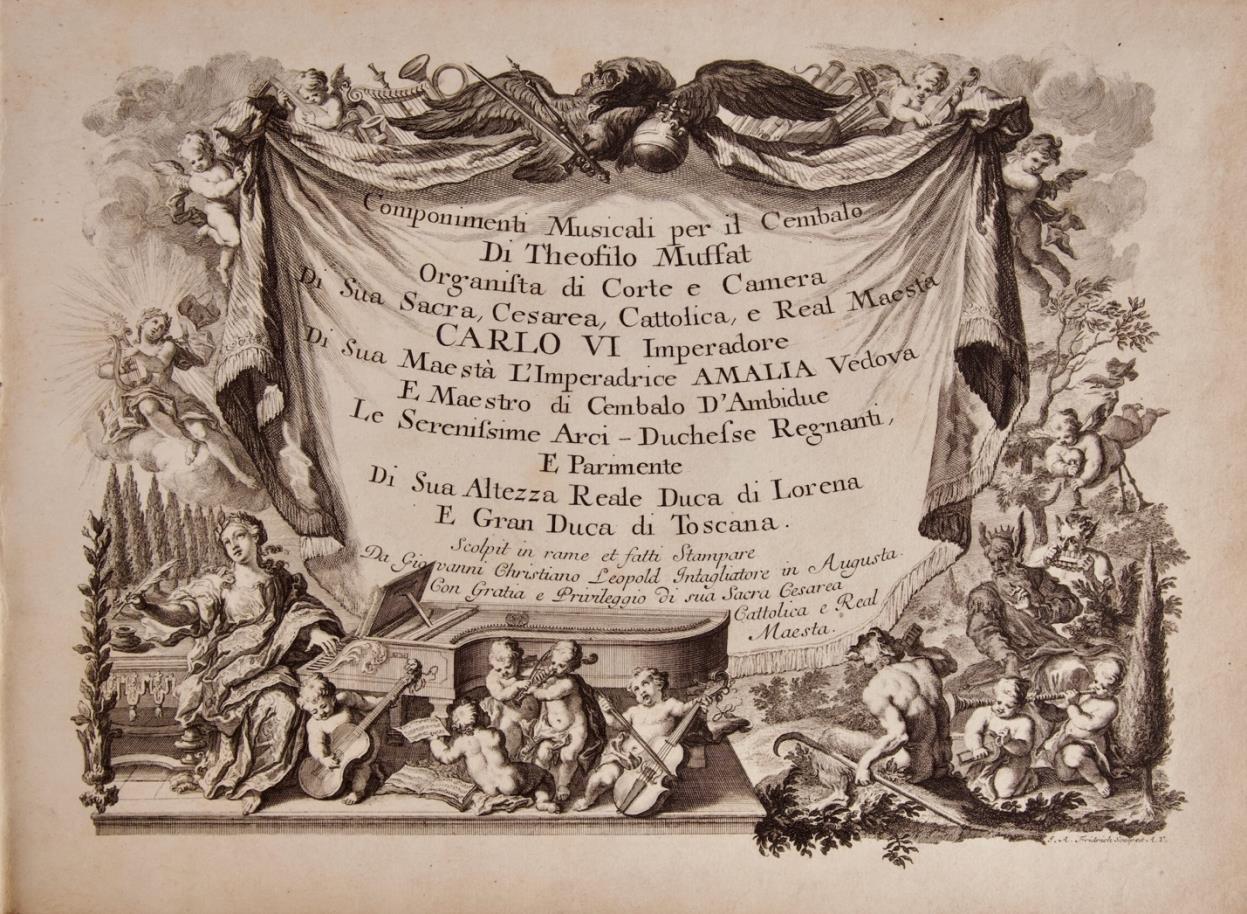
CONDITIONS OF SALE
All items are in good antiquarian condition unless otherwise noted and are offered subject to prior sale, with prices net and subject to change without notice. The costs of shipping and insurance are additional Orders are customarily shipped via USPS Priority Mail or Federal Express. Sales tax will be added to the invoices of NewYork State residents.
Orders may be placed by e-mail (info@lubranomusic.com), telephone (516-922-2192), or on our secure website (www.lubranomusic.com) by entering the ID number of the desired item in the SEARCH box at the upper right of our homepage.We ask that you kindly wait to receive ourinvoice to ensure availability before remitting payment. Libraries may receive deferred billing upon request.
We accept payment by:
- Credit card
- PayPal to info@lubranomusic.com
- Checks in U.S. dollars drawn on a U.S. bank
- International money order
- EFT (Electronic Funds Transfer), inclusive of all bank charges
-ACH (Automated Clearing House), inclusive of all bank charges
We fully guarantee that all items offered for sale by J & J LubranoMusicAntiquarians LLC are absolutely authentic without time limitation to the original purchaser provided that said items conform exactly to our description as supplied at time of purchase.All items remain the property of J & J Lubrano MusicAntiquarians LLC until paid for in full.
Please visit our website at
www.lubranomusic.com
where you will find full descriptions and illustrations of our catalogued inventory
Members
Antiquarian Booksellers’Association ofAmerica
International League ofAntiquarian Booksellers ProfessionalAutograph Dealers’Association
Music LibraryAssociation
American Musicological Society
Dance StudiesAssociation &c.
Cataloguers
John Lubrano, Jude Lubrano, Benjamin Katz
©
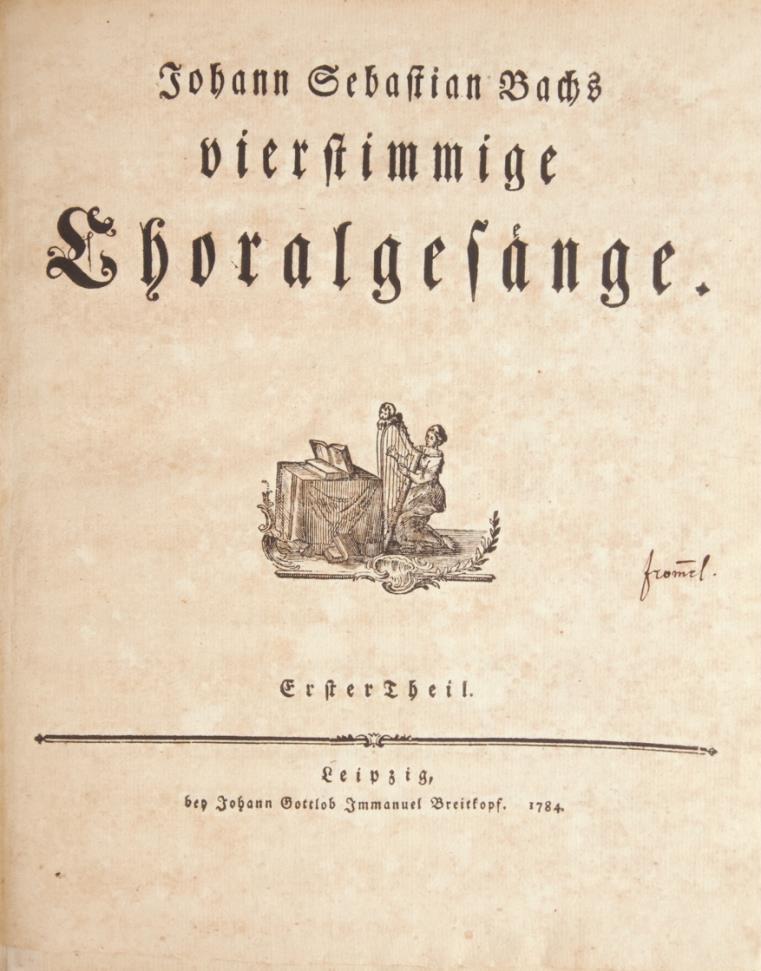
First Complete Edition of the Chorales Edited by C.P.E. Bach and Kirnberger
1. BACH, Johann Sebastian 1685-1750
Johann Sebastian Bachs vierstimmige Choralgesänge. Erster [-Zweyter, Dritter, Vierter] Theil. [BWV 253-438]. [Four-part chorales]. Leipzig: Johann Gottlob Immanuel Breitkopf, 1784-1787.
Quarto. Contemporary dark brown morocco-backed marbled boardswith mid-brown title label giltto spine, yellow edges. Woodcut device to each title, that to the first part depicting a woman playing a harp reading from music set upon a table, that to other parts depicting angels playing a lyre. Small handstamp of Otto Frommel Heidelberg to upper outer corner of free front endpaper and verso of foreword, with his signature toblankoutercornerofErsterTheil;smallinventorylabeltoupperoutercorneroffrontpastedown.Binding slightly worn rubbed, and bumped.Some signs of wear; numerous leaves quite browned; occasionalfoxing; very small tears to several blank margins; gutter of foreword reinforced with narrow strip of archival tape; following two leaves likewise, with additional reinforcement to upper and inner margins.
Erster Theil, 1784 1f. (recto title, verso blank), 1f. ("Vorrede" by C.P.E. Bach), 54 pp.
Zweyter Theil, 1785 1f. (recto title, verso blank), 55-108 pp.
Dritter Theil, 1786
1f. (recto title, verso blank), 111-164 pp.
Vierter Theil, 1787
1f. (rectotitle, verso blank),167-213,214-218("Verzeichnis der Choräle1sten, 2ten,3tenund 4tenTheile") pp.
First complete edition, edited by J.S. Bach's son Carl Philipp Emanuel Bach and Johann Philipp Kirnberger. Schmeider (2), p. 482. Schneider, p. 113. Kinsky: Die Originalausgaben, p. 83. Krause Leipzig Catalogue 135. Stuttgart catalogue 61. BUC, p. 78. Hoboken I, 31-34. RISM B449.
"Chorales such as BWV 371, conceived with orchestral forces in mind, act furthermore as reminders that chorales were Bach's favourite medium of instruction. C.P.E. Bach wrote in 1775: 'His pupils had to begin by learning four part thoroughbass. After that he went on with them to chorales; first he used to write the bass himself, then they had to invent the alto and tenor for themselves ... this way of leading up to chorales is indisputably the best way of learning composition, including harmony.' ...
The posthumously published collections (Birnstiel, 2 vols., 1765, 1769; Breitkopf, 4 vols., 1784-7) contain almost all the chorales known from Bach's vocal works, some under different titles. The present Breitkopf edition, prepared by C.P.E. Bach and Kirnberger, contains 371 chorales, among them more than 100 not found in the extant vocal works. This provides an important pointer to the lost vocal music, and though extremely difficult to follow up it has borne some fruits, as in the reconstruction of the St. Mark Passion or the Picander cycle. It is worth remarking that the number of excess chorales, that is those that cannot be assigned to extant works, more or less corresponds to the number thought to exist in the lost cantatas and Passions." Christoph Wolff and Walter Emery in Grove Music Online
Otto Frommel (1871-1951), born in Heidelberg, was a Protestant theologian; he studied theology, history, and musicology. (40379) $5,000
With Extensive Manuscript Figures Illuminating 18th Century Performance Practice From the Collection of Noted Musicologist, Henry Prunières
2. BASSANI, Giovanni Battista ca. 1657-1716
Harmonia Festiva Being the Eighth Opera of Divine Mottetts[!] ... For a Single Voice with Proper Symphonies Wherein are the Celebrated Mottetts of Quid Arma, quid Bella, and Alegeri Amores. London: Printed for William Pearson, for John Cullen at the Buck between the two Temple-Gates, Fleet-street and John Young at the Dolphin and Crown in St. Paul's Church-Yard Where may be had his Thirteenth Opera, [1708].
Folio. Modern quarter dark tan mottled calf with dark green mottled boards, titling gilt to spine, dark green mottled endpapers. 1f. (recto title, verso blank), 1f. (recto title printed in red and black, verso blank), 84 pp., with contents to lower portion of final page. Typeset throughout. The two violin parts for the symphonies are not included with this vocal score; the symphonies are, instead, notated solely as basso continuo. Binding slightly worn, rubbed, and bumped. Uniform minor to moderate browning; moderate foxing, soiling, and staining; title slightly browned, soiled, and foxed, with minor creasing; repairs mostly to lower outer corners of approximately ten leaves;paper repair to lower blank outer margin and lower right portion of p. 25 obscuring one measure of vocal part.
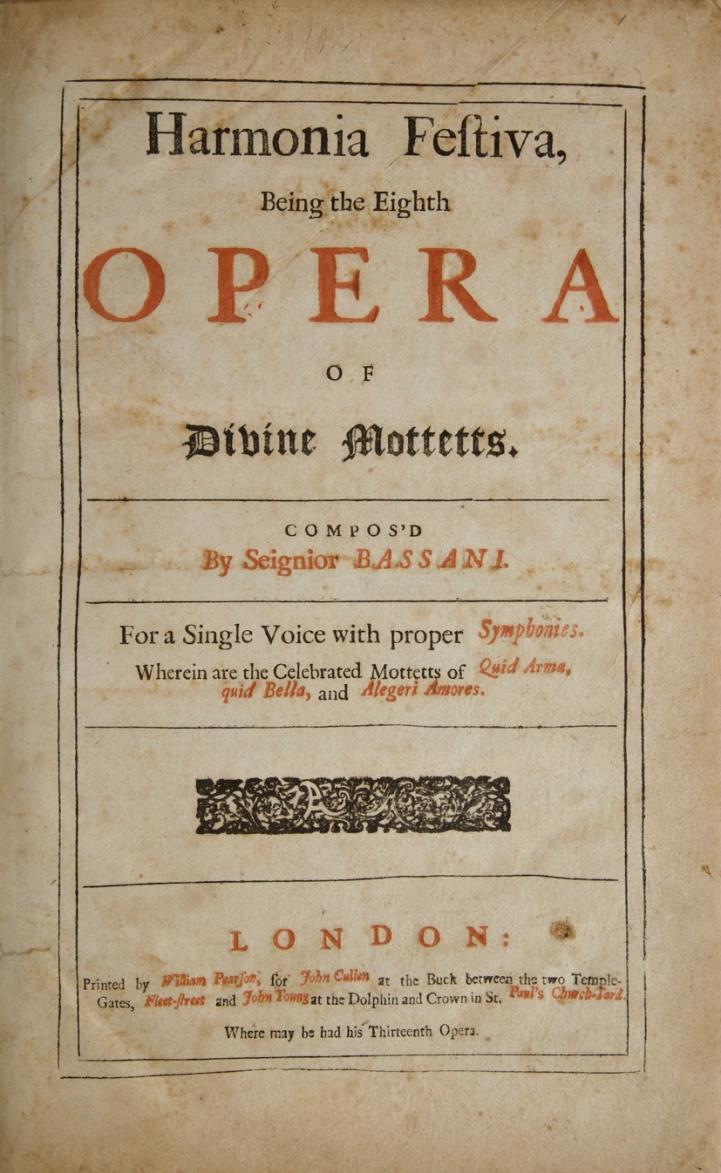
Provenance
Henry Prunières (1886-1942), distinguished French musicologist and collector, with his pictorial bookplate to front pastedown. Collection MusicalAndré Meyer I, p. 19, Sotheby's Paris, 16 and 17 October 2012, lot. 25.
With numerous supplemental figures added above the bass line in contemporary brown ink
BUC, p. 89. RISM B1184 and BB1184.
"Bassani's music was prominent in the middle Baroque period in Italy, when the concertato style predominated. His sacred works in this style are typical of those of the Bolognese school of composers in the last quarter of the 17th century, such as G.P. Colonna, G.B. Vitali and G.A. Perti. Perhaps above all he should be recognized for his solo cantatas, both sacred and secular. Yet although he was a prolific composer of other types of vocal music too, his fame has rested chiefly on his trio sonatas for strings. During his lifetime he was celebrated as a violinist. Some even considered his playing superior to Corelli's, a reputation probably enhanced by Burney, who also claimed that no one before him had written quite so idiomatically for the violin." Peter Smith, revised by Marc Vanscheeuwijck in Grove Music Online
The contemporary figures inmanuscript are a valuable document of early 18thcentury performance practice. (40398) $1,200
18th Century Etching of the Noted Composer and Organist
3. [BOYCE, William 1710-1779]
Dr. Wm. Boyce, Master of His Majesty's Band of Musicians. Drawn from the Life & Engrav'd by I. K. Sherwin Engraver to His Majesty & His Royal Highness the Prince of Wales. Publish'd as the Act directs Decr. 1st. 1788. Etching. London, 1788.
Image 320 x 254 mm; sheet size 354 x 265 mm. Laid down to mat.
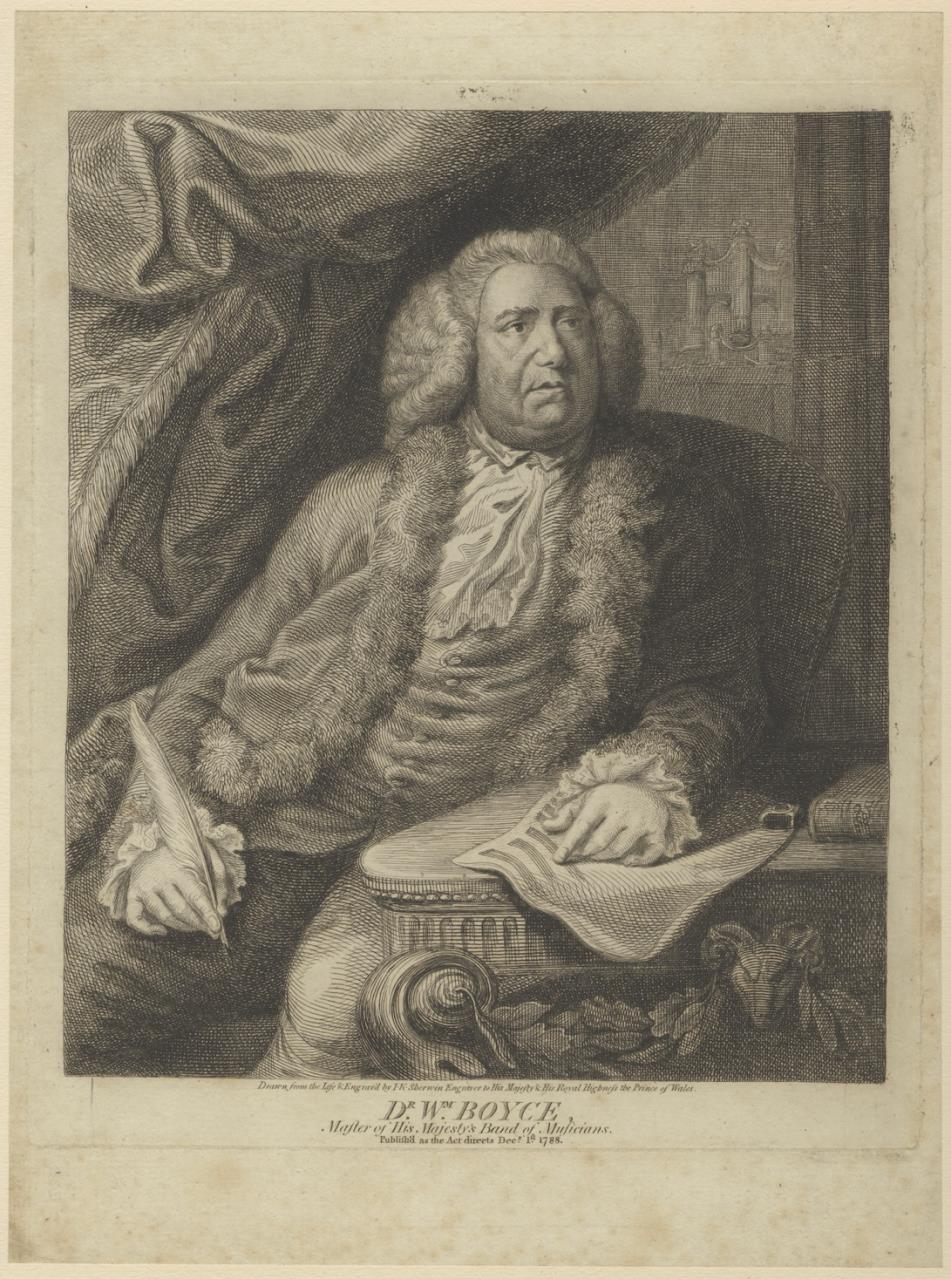
Boyce is seated holding a quill in his right hand and his left rests on a piece of blank music paper on a table. Close by is a an inkwell and a book, presumably of his music, with his name to the spine. He wears a fur edged coat, a waistcoat, ruffled shirt and a wig. In the background, behind the composer, and between drawn curtains, is a view of a large organ in the distance. Slightly foxed.
Boyce was a noted English composer, organist, and editor. "Though formerly best known for some of his anthems and his editing of Cathedral Music (1760–73), the significant contribution he made to instrumental music, song, secular choral and theatre music in England is now widely recognized." Ian Bartlett, and Robert J. Bruce in Grove Music Online (40405) $375
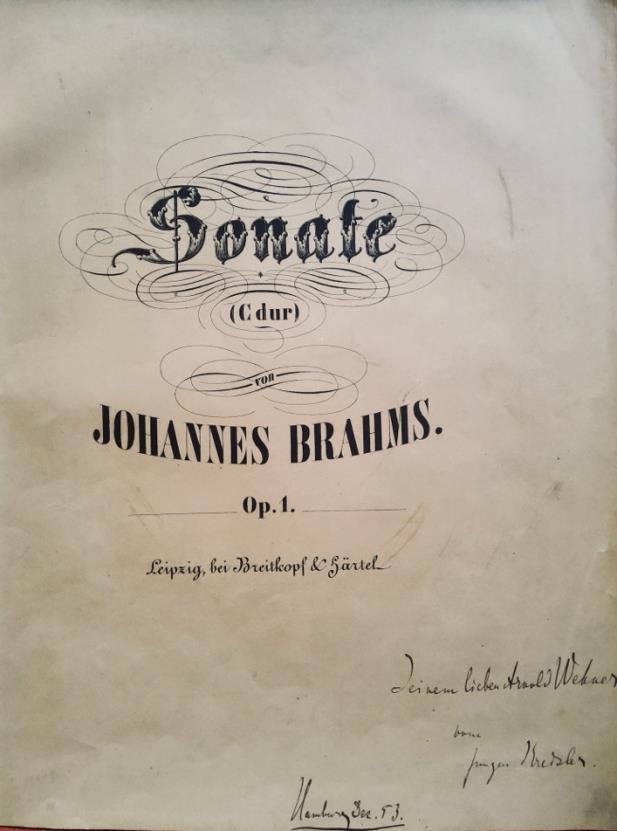
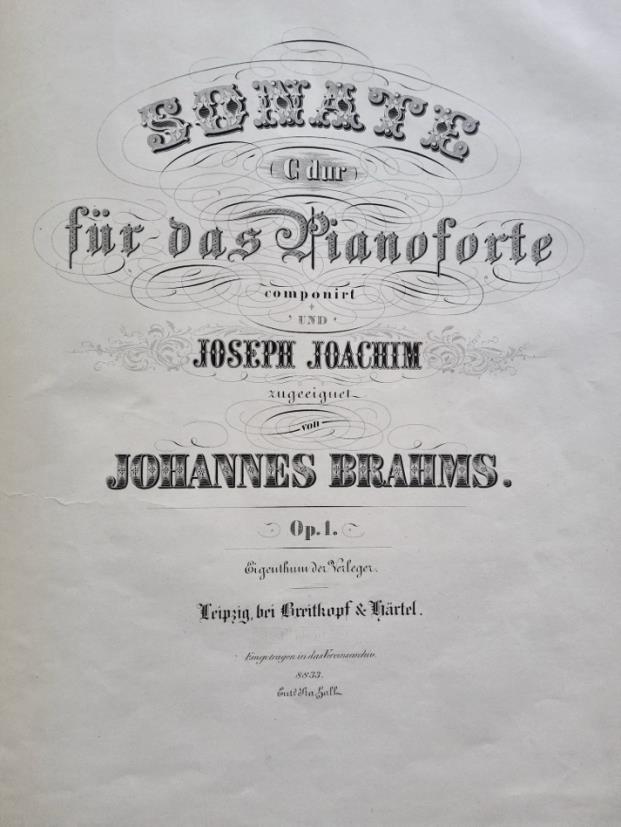
Opus 1 Presentation Copy
Inscribed and Signed by Brahms to Arnold Wehner
4. BRAHMS, Johannes 1833-1897
Sonate (C dur) für das Pianoforte componirt und Joseph Joachim zugeeignet von Johannes Brahms. Op. 1. Eigenthum der Verletger ... Eingetragen in das Vereinsarchiv. 8833. Ent. Sta. Hall. Leipzig: Breitkopf & Härtel [PN 8833], [1853].
Folio. Original publisher's dark ivory printed upper wrapper. 1f. (recto title, verso blank), 3-31, [i] (blank) pp. Title lithographed, music engraved. In custom-made dark red morocco clamshell box with dark red cloth boards, black morocco title label gilt to spine. Occasional fingerings and other performance markings including one correction, possibly in Wehner's hand. Upper wrapper slightly worn, soiled, and creased; lower wrapper lacking. Minor internal wear, soiling, and creasing; sewing to some signatures loose. A very good copy overall.
A presentation copy, with an autograph inscription to the composer's close friend Arnold Wehner to lower outer corner of upper wrapper: "Seinem lieben Arnold Wehner vom jungen Kreisler. Hamburg Dec. 53" (To his dear Arnold Wehner from the young Kreisler. Hamburg Dec. 53).
Brahms signs himself as Kreisler junior, adopting the name of the character Johannes Kreisler who features as a moody, asocial composer in E.T.A. Hoffmann's novels such as Kreisleriana (1813), and Johannes Kreisler, des Kapellmeisters Musikalische Leiden (1815).
First Edition, rare issue without the printed price, copies of which were set aside by the publisher for the composer to either be given as gifts or exported. McCorkle, p. 3. Hofmann, p. 3. Hoboken 4, 1. Deutsch 1.
"Brahms's early works are dominated by the piano, the instrument on which he, like most composers of the period, received his training. As both recitalist and composer he seemed from the start intent on transcending the virtuoso and salon traditions that dominated Europe in the 1830s and 40s.
The first group of piano works, opp. 4, 2, 1 and 5, completed (in that order) between 1851 and 1853, display an impressive command of the kind of motivic development and large-scale structures Brahms studied in Bach and Beethoven, a talent for the thematic transformation and colouristic harmony of Liszt and Chopin, and a strongly poetic-literary inclination like that of Schumann. ...
The slow movements of the three piano sonatas are character pieces, or songs without words. They reflect the predilection for folk materials also evident in Brahms's early lieder. The theme of the Andante of op.1 is ‘Verstohlen geht der Mond auf’, whose text Brahms reproduced under the notes and identified as ‘an old German Minnelied’ (though the melody is a recasting of one probably invented by Kretzschmer and Zuccalmaglio, the modern compilers of Brahms's source).
The successor to Beethoven and Schubert in the larger forms of chamber and orchestral music, to Schubert and Schumann in the miniature forms of piano pieces and songs, and to the Renaissance and Baroque polyphonists in choral music, Brahms creatively synthesized the practices of three centuries with folk and dance idioms and with the language of mid- and late 19th-century art music." George S. Bozarthand Walter Frisch in Grove Music Online
Wehner (1820-1880), a pupil of Mendelssohn, met Brahms through Joachim at Göttingen in the summer of 1853, where Wehner had been director of music since 1846. Brahms visited Wehner's home frequently while in Göttingen, performing a Bach concerto for two pianos together with him at the Zur Krone inn there. The two men remained in contact for some time thereafter, with Brahms writing to Joachim in the autumn of that year mentioning Wehner's urging the composer to go to Leipzig.
In addition to op. 1, Brahms signed a number of his other works as "Kreisler junior," including Opp. 2, 3, 5, and 8.
"That Kriesler Junior's signature first appeared on Brahm's transcription of Weber's Rondo rather than an original composition demonstrates his respect for the greatest masters and suggests that Brahms initially envisaged the persona more as a collaborator - even an amanuensis - than as an independent creative ego.
The nature of Brahms's relationship with Kreisler was transfigured by his encounter with Robert Schumann in the autumn of 1853 and the new-found enthusiasm for his mentor's music and aesthetics that ensued. In particular, Brahms seems to have been fascinated by the distillation of Schumann's psycho-musical tendencies into the personae of Florestan and Eusebius. In the summer of 1854, after Robert Schumann's breakdown, Brahms cast himself and Kreisler in Schumannesque roles when writing to Clara: 'I often quarrel with myself- that is, Kreisler and Brahms quarrel with one another." Moseley: Reforming Johannes Brahms, Kreisler Junior and the Piano Trio in B. Op. 8 in the Journal of the Royal Musical Association, 2007, Vol. 132, No. 2, pp. 258-259. (40415) $9,500
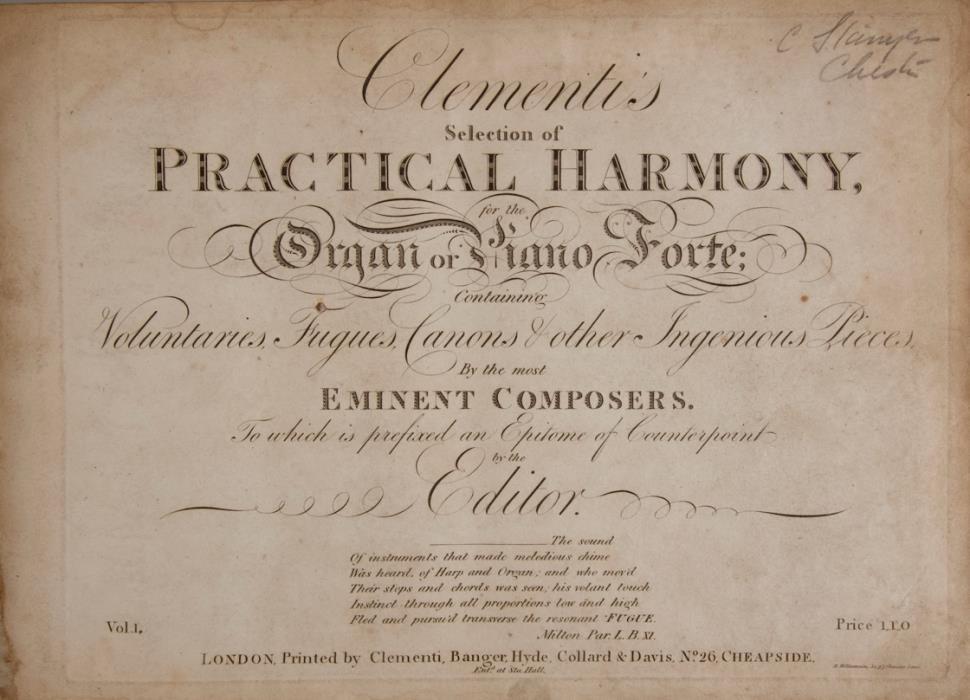

Including First Editions of Two J.S. Bach Works
5. CLEMENTI, Muzio 1752-1832
Clementi's Selection of Practical Harmony for the Organ or Piano Forte; Containing Voluntaries, Fugues, Canons & other Ingenious Pieces By the most Eminent Composers. To which is prefixed an Epitome of Counterpoint by the Editor ... Vol. I [-IV] ... Price 1.1.0. [WO 7].
4 volumes bound in 2. Oblong folio. Late 19th century half dark red leather with dark red cloth boards, gilt rules to uppers, spine in decorativecompartments gilt, titling gilt, marbled endpapers. Engraved throughout. Bindings worn, rubbed, and bumped; upper to Vols. II/II detached; endpapers stained. Occasional wear, soiling, staining, and foxing; several small tears repaired.
Vol. I
1f. (recto title, verso blank), [i] (Index), 2-145 pp. Imprint Clementi, Banger, Hyde, Collard & Davis. Watermark 1801. Plate numbers and publication dates incorrect in Schmieder (see Tyson, p. 103). With annotation to title in pencil "[?]C Staimper Chesli," with slip of paper laid down to blank verso with autograph inscription in Clementi's hand "Mr. Banks, from the Author." Occasional later annotations in pencil ("Very good," and "What will bear comparison with the beauty of this"), referring to a "Fuga a 2" by Handel, Vol. I, pp. 36-37. With two J.S. Bach first editions, the Pièce d'Orgue, BWV 572 (Schmeider 2, p. 535) and the French Suite No. 1 in G major, BWV 816 (Schmeider 2, p. 618).
Vol. II
1f. (recto title, verso blank), [i] (Index, 2-157 pp. Imprint Clementi, Banger, Hyde, Collard & Davis. Watermark 1805
Vol. III
1f. (recto title, verso blank), [i] (Index), 123, [i] (blank) pp. Imprint Clementi, Banger, Collard, Davis & Collard. Watermark 1819
Vol. IV
1f. (recto title, verso blank), [i] (Index), 2-121 pp. Imprint Clementi, Banger, Collard, Davis & Collard. Watermarks 1810-1816
Tyson, p. 103. RISM C3143 and CC3143 (4 complete copies only in the U.S.).
Clementi's only contribution, the "Epitome of Counterpoint," appears in Vol. I, pp. 1-7. The majority of the music in the present collection is drawn from 18th century Italian and German composers including Kirnberger, Marpurg, Padre Martini, Porpora, and the Bach family, with the occasional inclusion of the music of earlier composers uch as Paolo Agostini, Girolamo Frescobaldi, and Cristoforo Caresana. These works, emphasizing fugue and counterpoint, were most likely used by Clementi in his teaching. There are also occasional transcriptions, including BWV 572, originally for organ; a fugue adapted from the choral Kyrie of Mozart's Requiem; and an A-major fugue of Porpora, originally for violin and continuo.
Clementi was an Italian-born English composer, keyboard player and virtuoso, teacher, music publisher, entrepreneur, and piano manufacturer of Italian birth. "From 1785 until 1802 Clementi remained in London and achieved great eminence first as a composer, performer, and teacher, and later as a publisher and instrument manufacturer. Named ‘principal composer and performer’ at the Hanover Square Grand Professional Concert (as they were now called) in 1786, he appeared as piano soloist in these programmes as well as in the rival series of La Mara-Salomon until 1790. During these years he also frequently performed in the annual round of benefit concerts – the beneficiary being the principal performer – and in the concertos presented between acts of oratorios at Covent Garden. ... Clementi was in great demand during this period as a piano teacher; according to Mrs Papendiek, an attendant at the court of George III, he once refused an application for tuition from the royal family itself. His pupils included members of many well-placed families in London who were willing to meet his reported fee of one guinea per lesson. He also gained fame as a teacher of ‘professional’ students. Among them were J.B. Cramer, the organist Arthur Thomas Corfe, the violinist and pianist Benjamin Blake, Theresa Jansen, Benoit-Auguste Bertini, and John Field." Leon Plantinga, revised by Luca Lévi Sala in Grove Music Online
A fascinating cross-section of 17th and 18th century music, curated for pedagogical purposes by Muzio Clementi, one of the 18thcentury's most influential musicians, andincluding two first editions of the works of J.S. Bach. (40429) $1,200
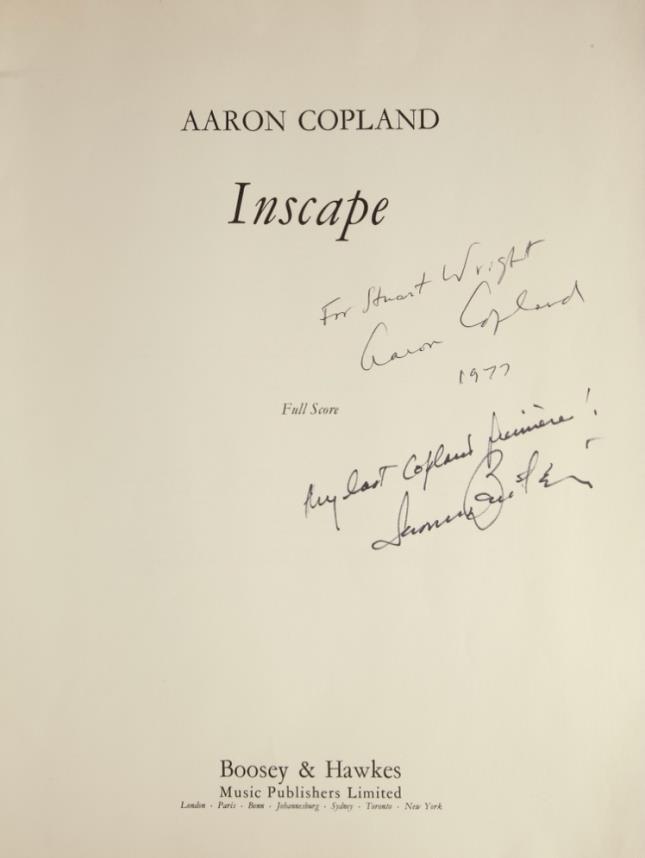
With a Signed Inscription from Both Copland and Leonard Bernstein
6. COPLAND, Aaron 1900-1990
Inscape. Full Score. London, Paris, Bonn, Johannesburg, Sydney, Toronto, New York: Boosey & Hawkes {PN B. & H. 19722], [1968].
Folio. Original publisher's light mustard yellow wrappers printed in dark brown. 1f. (recto title, verso blank), 1f. (recto orchestration and notes, verso blank), 47, [i] (blank) pp. With original price label to blank upper outer corner of upper wrapper ("15.00") and publisher's catalogue to verso of lower wrapper listing Copland's including operas and ballets and orchestral, instrumental, vocal, choral, and band works. Preserved in a custom-made dark reddish brown leather clamshell box with dark brown cloth boards, raised bands on spine with titling gilt. Very slightly worn and soiled. In very good condition overall.
With an autograph inscription to noted collector and author Stuart Wright to title signed in full by Copland and dated 1977 and an additional inscription by highly distinguished composer and conductor Leonard Bernstein: "My last Copland première! Leonard Bernstein."
First Edition.
Composed in 1967, Inscape was commissioned by and dedicated to the New York Philharmonic in celebration of its 125th anniversary. The piece, Copland's fourth "and essentially last" work employing the 12-tone technique, was first performed by the orchestra under Bernstein's direction at the University of Michigan in Ann Arbor on 13 September 1967 during its pre-season tour.
"The title Inscape derived from the writings of Gerard Manley Hopkins (1844-1889), the Victorian poetpriest ... Copland had long admired Hopkins, an enthusiasm possible explained by his friendship with Britten, who was working on some Hopkins settings when he and Copland spent the summer together in 1939. ... Hopkins coined the word inscape to describe the essential qualities of things, which he contrasted with instress, meaning one's perceptions of things. ... Copland thought music particularly well matched to such ideas, in that the composer uses sounds as an "instress" that communicates a deeper inner essence, an "inscape." Pollack: Aaron Copland, pp. 505-506.
"One of his country’s most enduringly successful composers, Copland created a distinctively American style and aesthetic in works of varying difficulty for a diversity of genres and mediums, including ballet, opera and film. Also active as a critic, mentor, advocate and concert organizer, he played a decisive role in the growth of serious music in the Americas in the 20th century." Howard Pollack in Grove Music Online
An outstanding association item linking two towering figures of 20th century American music (40414) $1,500
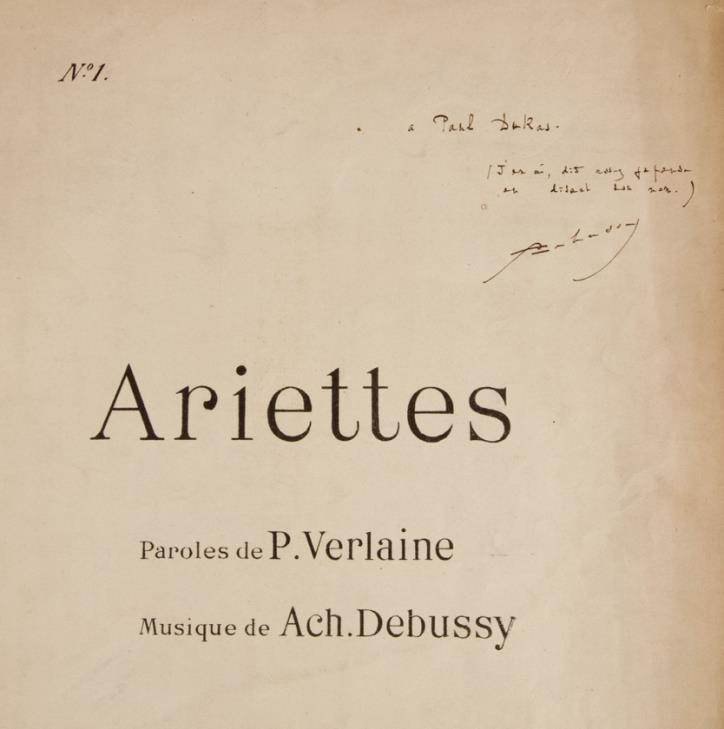
Presentation Copy, Inscribed to Fellow Composer Paul Dukas
7. DEBUSSY, Claude 1862-1918
Ariettes No. 1 ["C'est l'extase langoureuse"]. Paroles de P. Verlaine Musique de Ach. Debussy. [Pianovocal score]. [Paris]: [E. Girod, Éditeur, Bould. Montmartre 16] [PN E.G. 6122], [1886].
Folio. Original publisher's ivory self wrappers. 3 pp. music. With publisher's catalogue, "Mélodies Célèbres," to verso of p. 3 including opening measures of 8 pieces by Vidal, Dubreuilh, Puget, and Granier. In a custom-made dark green leather-backed clamshell box with marbled boards, spine with titling and decorative devices gilt. Wrappers slightly worn, soiled, and lightly creased; minor browning; small edge
tears and chips; spine reinforced with tape with resulting minor staining to inner margin of lower wrapper. Bookplate of noted music collector David Wolman to front pastedown of clamshell box.
A presentation copy, with autograph inscription to fellow composer Paul Dukas signed by Debussy to upper wrapper, in translation: "To Paul Dukas - I've said enough, I think, in saying your name, A[chille] Debussy."
First Edition of this, the first of the six Ariettes Oubliées, set to poems by Paul Verlaine. Lesure 60. Vallas Catalogue, p. VIII.
"In 1887, [Debussy] renewed his friendship with a young student at the Conservatoire who was three years his junior, Paul Dukas, primarily because both of them were able to discuss subjects other than just music: 'We considered it genteel to speak as little as possible about music.' Dukas's father was a scholar who specialized in the Orient. The two young composers would celebrate their get-togethers by having lunch along the boulevards, at the 'Diner européen,' and then walking together in the Bois de Boulogne, exchanging their ideals and aspirations.' " Lesure: Claude Debussy, p. 73
"The next few years [after 1887] were a time of financial struggle for Debussy. He frequented the literary and artistic cafés where the symbolists gathered, and formed friendships with Paul Dukas, Robert Godet and Raymond Bonheur. ... Two of his Ariettes oubliées were performed by the Société Nationale de Musique and he began to compose the Cinq poèmes de Baudelaire and the Fantaisie for piano and orchestra. It was the most Wagnerian period of his life: he went to Bayreuth in 1888 and 1889, but eventually recognized that he had to free himself from Wagner’s influence. ...
One of the most important musicians of his time, [Debussy's] harmonic innovations had a profound influence on generations of composers. He made a decisive move away from Wagnerism in his only complete opera Pelléas et Mélisande, and in his works for piano and for orchestra he created new genres and revealed a range of timbre and colour which indicated a highly original musical aesthetic." François Lesure, and Roy Howat in Grove Music Online
French composer, critic, and teacher, "Dukas [1865-1935] was not only an influence on many French 20thcentury composers and others such as Zemlinsky and Berg, but also remains important in his own right. His reputation rests on only a small number of compositions, notably the Piano Sonata, Ariane et Barbebleue, the ballet La Péri and L'apprenti sorcier. Dukas's influence as a critic, from 1892 to 1932, can be compared with Debussy's; his informed opinions reveal great sensitivity to the musical and aesthetic changes that took place during the period." Manuela Schwartz, and G.W. Hopkins in Grove Music Online A fine association copy linking two major late 19th-early 20th century French composers. (40416)
$2,500
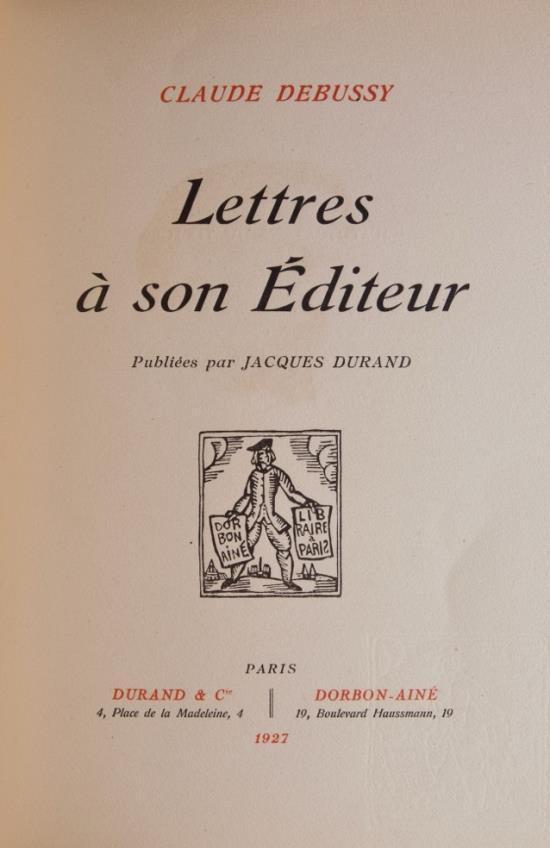
Letters from Debussy to His Publisher
Signed by Distinguished Soprano Lily Pons
8. DEBUSSY, Claude 1862-1918
Lettres à son Éditeur. Paris: Durand & Cie ... Dorbon-Ainé, 1927.
Quarto. Full blackcloth with black leathertitle label gilt tospine, original publisher's ivorywrappersprinted in red and black with engraved publisher's device printed in dark green bound in. 1f. (blank), 1f. (recto halftitle,versoblank),1f.(rectotitleprintedinredandblack,versolimitationstatement),[3]-4("Avant-Propos" by J.D.), [6]-190, 1f. ("In Fine" by J.D. dated Bel-Ebat, Septembre 1926, verso blank), 1f. (recto Index, verso blank). With three-quarter length reproduction photographic portrait of the composer tipped-in opposite p. 37. An uncut copy, with two final leaves unopened. Wrappers worn and soiled, with dampstain to lower outer portion; uniform light browning; half-title and preceding leaf slightly more heavily browned atmargins;pp. 44-45 browned;margins of several leaves slightly unevenly opened resulting in minor paper loss; minor loss to blank outer corner of pp. [5]-[6], to blank outer margin of pp. 127/128, and to blank upper margin of pp. 159/160; staining to outer margins of pp. 62-63; small tear to blank margin of pp. 113/114 repaired with archival tape; 4 small stab marks without puncture, most noticeable to final several leaves. Lacking frontispiece portrait etching by Ivan Thiele after his original charcoal sketch executed in 1913 held by the Tretiakoff Museum in Moscow.
With the autograph signature of distinguished French-born American soprano Lily Pons dated 1956 to half-title.
First Edition, limited to 250 copies, this number 7.
"One of the most important musicians of his time, [Debussy's] harmonic innovations had a profound influence on generations of composers. He made a decisive move away from Wagnerism in his only complete opera Pelléas et Mélisande, and in his works for piano and for orchestra he created new genres and revealed a range of timbre and colour which indicated a highly original musical aesthetic." François Lesure, and Roy Howat in Grove Music Online
Jacques Durand (1865-1928), son of the founder of the important French music publishing firm A. Durand & Fils, became a partner in the firm in 1891. Durand-Schoenewerk & Cie [antecedent of A. Durand & Fils] published Debussy's string quartet in 1894 "and in 1903 composer and publisher began a close relationship which was to last until Debussy's death." Roger S. Nichols, revised by Nigel Simeone, and Jeremy Drake in Grove Music Online. The present volume documents this significant relationship betweencomposer and publisher.
Pons made her debut with the Metropolitan Opera in New York in 1931 as Lucia. "She caused a sensation and thereafter remained with the company for 28 seasons." Dennis K. McIntire, revised by Alan Blyth in Grove Music Online (40403) $200
Collection of Songs by the “Father of American Music” Many in First Edition, First Issue
9. FOSTER, Stephen 1826-1864
A collection of 16 songs, 11 in first edition, first issue, by the "Father of American Music"
Folio. Disbound. Contents as follows:
1. Cora Dean Song. Written and Composed by Stephen C. Foster ... 2-1/2 ... Foster's Melodies No. 47. New York: Firth, Pond & Co., 547 Broadway [PN 4824], 1860. 1f. (recto title within decorative border, verso blank), 3-5, [i] (blank) pp. With small oval partial handstamp to blank lower margin of title. First Edition. Fuld: Foster, 21.
2. Eulalie. Song. Written by H.S. Cornwell ... Pr. 25 C Nett. New York: Firth, Pond & Co. No 1 Franklin Sq. [PN 1453], 1851. 1f. (recto title with calligraphic flourishes, verso blank), 3-5, [i] (blank) pp. With small oval Fredericksburg, Va. bookseller handstamp to blank lower margin of title. First Edition. Fuld: Foster, 30.
3. Farewell My Lilly Dear. A Plantation Melody as sung by Christy's Minstrels. Written & Composed by S.C.F. Pr 25 C Nett. New York:Firth, Pond & Co. No 1 Franklin Sq. [PN 1456], 1851. 1f. (recto title, verso blank), 3-5, [i] (blank) pp. First Edition, later issue. See Fuld: Foster, 33.
4. I see her still in my dreams. Ballad. Poetry and Music by Stephen C. Foster. ... 2-1/2. Foster's Melodies No. 52. New York: Firth, Pond & Co., 547 Broadway [P{N 4275], 1857. 1f. (recto title on decorative ground, verso blank), 3-5, [i] (blank) pp. With small oval handstamp of F. Hartel & Co. Pianos & Music to blank lower margin of title. First Edition. Fuld: Foster, 53.
5. Linger in Blissful Repose. Serenade ... Written & Composed by Stephen C. Foster. 3/1/2. Foster's Melodies No. 34. New York: Firth, Pond & Co., 547 Broadway [PN 4116], 1858. [i] (illustrated title), 2-5, [i] (blank) pp. Trimmed at upper and lower margins affecting imprint. With lithographic title by Sarony, Major & Knapp printed in shades of white, gray, and black on a teal blue/gray ground depicting a night
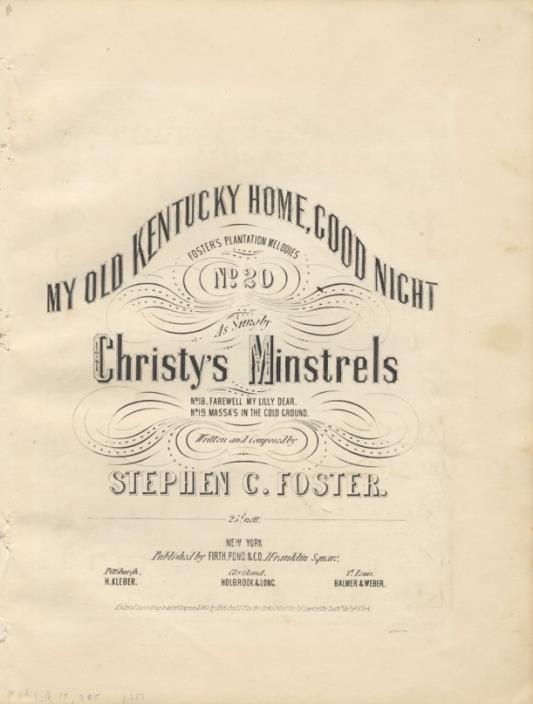
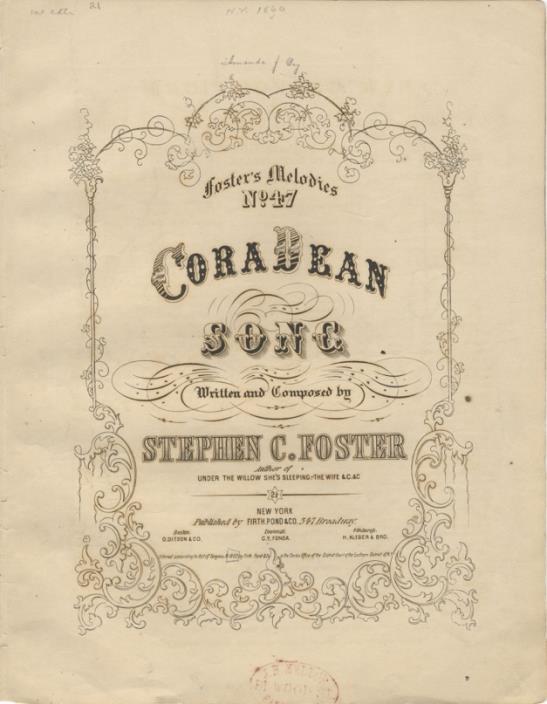
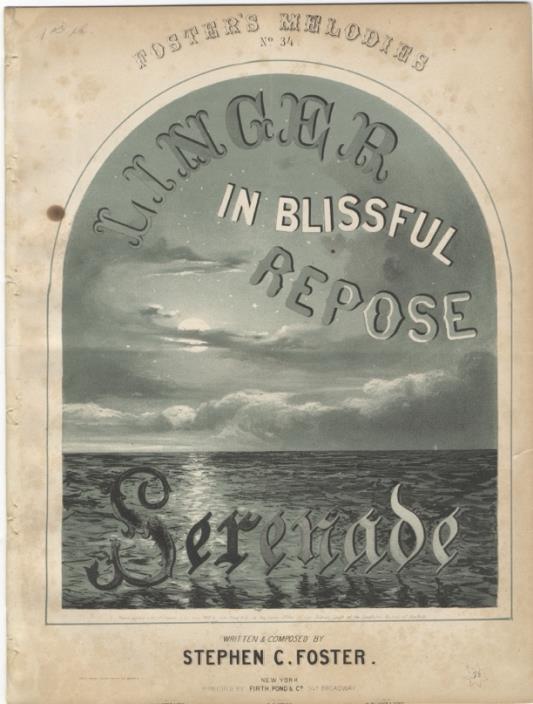
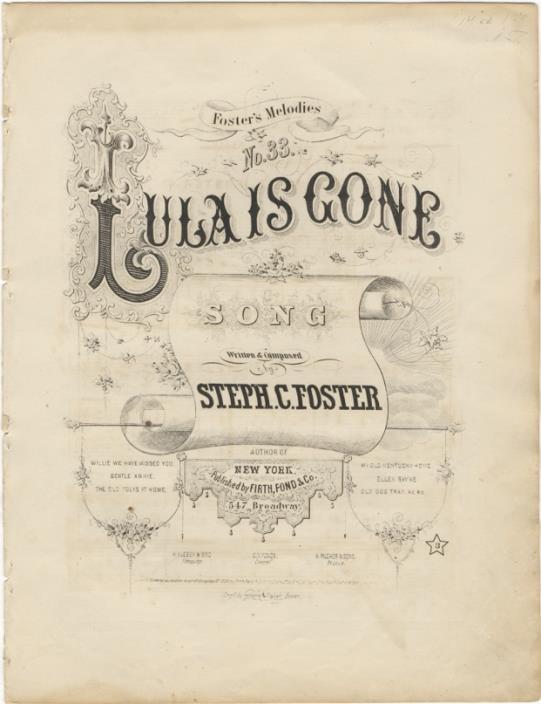
scenewith moonlightshining on a darkseaundercloudedskies. First Edition, later issue. See Fuld: Foster, 75.
6. Lula is Gone. Song. Written & Composed by Steph. C. Foster ... 3 ... Engd. By Green & Walker, Boston. Foster's Melodies No. 33. New York: Firth, Pond & Co., 547 Broadway [PN 4395], 1858. [i] (title on decorative ground), 2-5, [i] (blank) pp. First Edition. Fuld: Foster, 86.
7. Molly! Do You Love Me? Song. Written & Composed for the Piano Forte by S.C. Foster. 25 Cts. net. Baltimore: F.D. Benteen; New Orleans: W.T. Mayo [PN 1706], [1850]. 1f. (recto title with calligraphic flourishes, verso blank), 3-5, [i] (blank) pp. First Edition. Fuld: Foster, 98.
8. My Old Kentucky Home, Good Night. Foster's Plantation Melodies No. 20. As Sung by Christy's Minstrels ... Written and Composed by Stephen C. Foster. 25 [cents] nett. New York: Firth, Pond & Co., 1 Franklin Square [PN 1892],1853. [i] (recto title with calligraphic flourishes), 2-5, [i] (blank) pp. First Edition. Fuld: Foster, 105.
9. My Wife is A [Most] Knowing Woman. New York: Horace Waters, No. 481 Broadway, 1862. 1f. (recto title printed in red and blue within decorative border, versoblank), 3-5 pp., [i] (publisher'scatalogue printed in blue). Small oval handstamp "Charlotte Blume 43 Fifth Street, Pittsburg, Pa" to lower portion; trimmed at upper and lower margins. First Edition. Fuld, Foster, 106.
10. "Oh Boys Carry Me 'Long" A Melody Written & Composed by Stephen C. Foster. ... 25 Cts. nett. New York: Firth, Pond & Co., 1 Franklin Square [PN 1133], 1851. [i] (title), 2-5, [i] (blank) pp. First Edition Fuld: Foster, 113.
11. Under the Willow She's Sleeping. Written and Composed by Stephen C. Foster ... Piano ... Guitar. 2/1/2. to Mrs. W.H. Whitney. Foster's Melodies No. 46. New York: Firth, Pond & Co. [PN 4825], 1860. 1f. (recto title within decorative border incorporating architectural and floral motifs, verso blank), 3-5, [i] (blank) pp. Foxed; edge tears; several small circular stains; gutters repaired with archival tape. First Edition, later issue. See Fuld: Foster, 170.
12. The Voices that are gone as sung by C. Henry of Wood's Minstrels Words by Robt. Campbell Esq. ... The Symphonies and Accompaniments by John P. Cooke. 3/1/2. To Miss Rebecca Wood. New York: Wm. A. Pond & Co., 547 Broadway [PN 6002], 1865. [i] (title within decorative border), 2-5, [i] (blank) pp. First Edition. Fuld: Foster, 176.
13. Way Down In Ca-I-Ro. Written & Composed by Stephen C. Foster. ... 25 [cents] nett. New York: Firth, Pond & Co., 1 Franklin Square [PN 629],1850. 1f. (recto title with calligraphic flourishes, verso blank), 35, [i] (blank) pp. First Edition. Fuld: Foster, 178.
14. What Must A Fairy's Dream Be! Ballad. Written & Composed for and respectfully Dedicated to Miss Mary H. Irwin ... Price 20 Cents Net. Louisville: Peters & Werster; Cincinnati: Peters & Field [PN 1120], 1847. 4 pp. First Edition. Fuld: Foster, 187.
15. Willie has gone to the war. Song & Chorus. Words by George Cooper, Esq ... 3. New York: Wm. A. Pond & Co. [PN 5595, 1863. [i] (title within decorative border), 2-4 pp. Lacking final leaf (p. 5 music, p. 6 blank). First Edition, later issue. Fuld: Foster, 200.
16. Willie We Have Missed You ... 38 Cts. Nett. New York: Firth, Pond & Co. [PN 2727], 1854. 1f. (recto lithographic title, verso blank), 3-6 pp. First Edition, later issue. Fuld: Foster, 202.
Prices often within stars.
With additional places and distributors noted below imprint including Albany (J.H. Hidley); Baltimore (F.D. Benteen); Boston (O. Ditson & Co.); Buffalo (J.R. Blodgett); Chicago (Root & Cady and B.K. Mould); Cincinnati (C.Y. Fonda); Milwaukee (H.N. Hempsted); Montreal (Boucher & Manseau); New Orleans (Wm. T. Mayo); Philadelphia (Lee & Walker); Pittsburgh (H. Kleber & Bro.); Rochester (J.P. Shaw); St. Louis (H. Pilcher & Sons) All pieces with evidence of having been removed from a bound
volume, with signs of wear, browning, foxing, soiling, and staining; small tears to edges, some repaired; archival tape to gutters; binder's holes to inner margins; and other minor defects.
A noted American songwriter of Scots-Irish descent, "Foster’s songs reflect both supremely positive and negative social morals, practices, and qualities, and they have had a strong part in developing performance and distribution media as well as worldwide notions of American identity. Thus, they have been beloved by many, reviled by others, and have circulated globally with unprecedented persistence from his time to ours. Consequently, the estimation of Foster as a composer varies widely. ...
A rise in the study of American music and worldwide interest in Americana since the 1980s, however, has brought new scholarly research into the songs’ history of interpretations and significance, accompanied by continued circulation among American country, folk-music, and popular performers and persisting use as iconic melodies for films, television shows, and electronic devices. In the 1850s Foster’s songs were the first significant body of identifiably American song; in the early twenty-first century, a handful of Foster’s songs remained among the best-known music in the world." Deane L. Root in Grove Music Online
A fine collection of songs, most in first edition, by a 19th century composer often referred to as the "Father of American Music.” (40441) $850
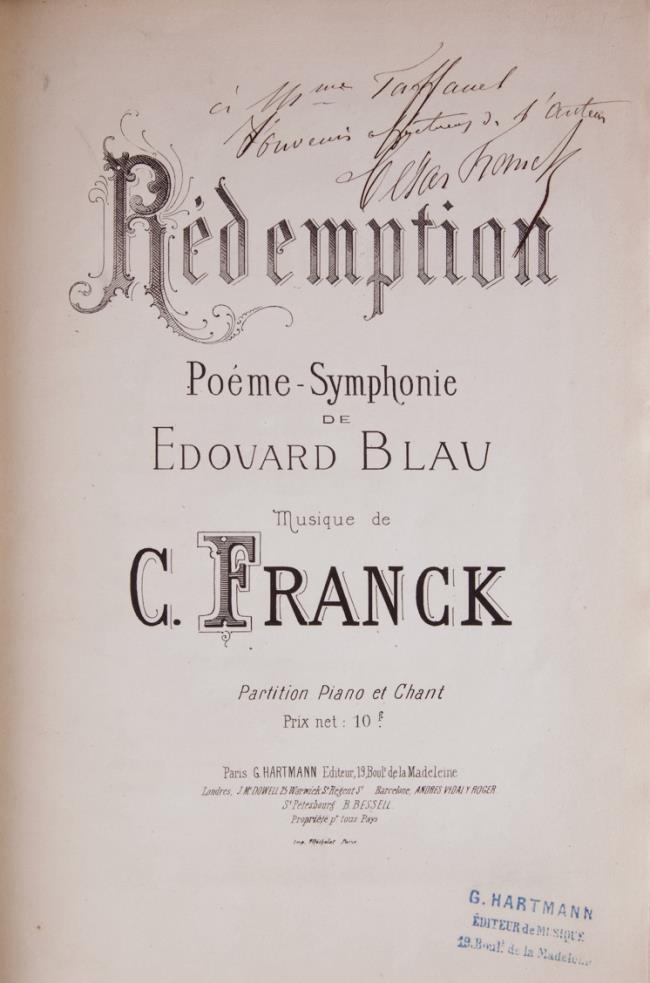
Inscribed and Signed by the Composer
10. FRANCK, César 1822-1890
Rédemption Poéme-Symphonie de Edouard Blau ... Partition Piano et Chant. Prix net: 10 f. [FWV 52]. Paris: G. Hartmann ... 19, Boul. de la Madeleine [PN G.H. 666], [1872].
Large octavo. 20th century half dark blue pebbled morocco with marbled boards, titling to decorative spine gilt, original publisher's light gray printed wrappers bound in. 1f. (recto title, verso blank), 1f. (recto contents, verso blank), [i] (blank), 2-133, [i] (blank) pp. Text in French. Engraved. Publisher's small mid-blue handstamp to blank lower outer corner of title.
Wrappers slightly worn and browned at margins; edges slightly dusty; final blank leaf laid down to recto of lower wrapper; pp. 25-32 misbound; minor abrasion to pp. 54-55, just touching staff lines and left side of one note. A very good, crisp copy overall
A presentation copy, with an autograph inscription by the composer to Madame Taffanel, wife of the French flautist Paul Taffanel, signed in full in black ink to upper blank margin of title.
First Edition of the first version of the work. Mohr, p. 295.
The first version of Rédemption, a work for soprano voices, speaker, and orchestra, was first performed at the Concert National (Colonne) on 10 April 1873; a final version, with a new chorus and symphonic interlude, was first performed at the Conservatoire on 15 March 1875.
Frank, a Belgian-born French composer, teacher, and organist, "was one of the leading figures of French musical life during the second half of the 19th century. ... According to Vincent d’Indy, Rédemption was the first work in which Franck applied his principles of ‘tonal architecture.’ " John Trevitt, revised by JoëlMarie Fauquet in Grove Music Online
A French flautist and conductor, "Taffanel [1844-1908] was the founder of the modern French school of flute playing which has since been widely adopted throughout the world." Edward Blakeman in Grove Music Online (40409) $450
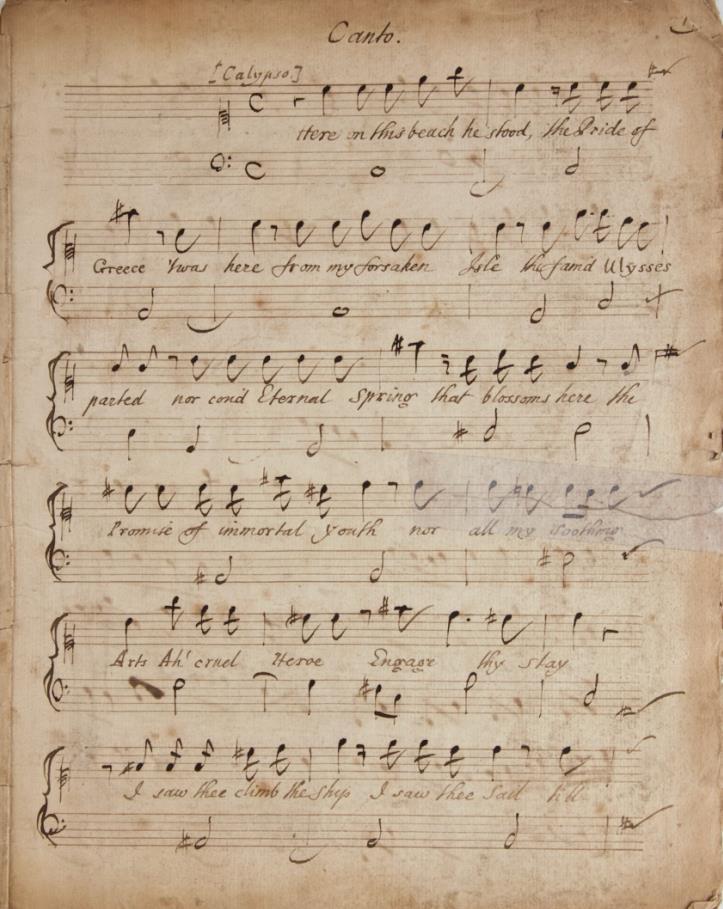
18th Century Opera Manuscript, with Unrecorded Recitatives
11. GALLIARD, John Ernest ca. 1687-1749
Opera of Calypso [and Telemachus] - first act 1. Canto 1. Tenore 1. Basso 1. Violino pmo. 1. Violino Secdo. 1. Alto Viola 1. Basso. Ex. 26. Septr. 1749. [Copyist manuscript set of parts]. England, 1749.
Vocal and instrumental parts in an unknown 18th century hand. Of English provenance. Watermark with Strasbourg lily and Roman numeral "VI." Folio (236 x 303 mm). Contemporary heavy paper wrappers. Notated in black in on 12-stave rastrum-ruled paper. Wrappers somewhat worn and soiled, with small tears to edges and minor loss to spine. Moderate browning to margins; minor loss to some edges and corners; paper repair to first leaf of canto part with final leaf heavily soiled.
Canto: 20 pp.
Tenore: 9 pp.
Basso [vocal score]: 23 pp.
Violino primo: 13, [i] (blank) pp.
Violino secondo: 13, [i] (blank) pp.
Alto viola: 10, [iv] (blank) pp.
Basso [continuo]: 6, [i] (blank) pp.
Occasional cancellations of 3-5 measures each.
First performed in London at the Queen's Theatre on 17 May 1712.
While The London Stage records 5 performances in 1712 and 5 in 1717, no later performances are listed.
Of considerable interest is the presence here of the recitatives for the first act of the opera; they do notappear in the published scoreof1712, andseem not tobe present inany otherextant manuscript sources.
These manuscript parts bear all the marks of practical performance materials. This is especially notable in the violin parts, which contain an accompanied recitative notated on two staves, the upper with the vocal part and occasional continuo interjections (rendered in smaller notation), and the lower with a highly figurative word-painting part. In addition, both the violin and viola parts contain cues from the recitatives: before each aria, the scribe includes a fragment of the final sentence of the recitative that precedes it.
Galliard, a German composer and oboist, active in England, "certainly played a significant role in London's musical life in the first half of the 18th century. He was a founder-member of both the Academy of Vocal (later Ancient) Music in 1726 and the Royal Society of Musicians in 1738, directing the first performance of the former. His translation of Tosi's singing manual is very felicitous, and he added some intelligent notes; he had known Tosi in London earlier in the century. Burney wrote of Galliard's music, ‘I never saw more correctness or less originality … Dr. Pepusch always excepted’, but he was rather more generous elsewhere in his History, and both he and Fiske recognized Galliard and Pepusch as the leading composers of English theatre music before the 1730s. Charles Didbin thought Galliard had ‘considerable genius’, and if Dr Kitchener is to be believed, Handel in old age told the youthful Samuel Arnold that he had so high an opinion of Calypso and Telemachus that he would sooner have composed it than any of his own operas. The story must have become distorted in the telling, but Handel surely expressed admiration in some degree." Roger Fiske, revised by Richard G. King in Grove Music Online
An important source, of great interest to performers and scholars of music and theater alike, with substantial unrecorded material from an influential opera (40212) $2,500
CHRISTOPH WILLIBALD GLUCK
Items 12-16
"Gluck was recognized as an extraordinary phenomenon in his lifetime, as is evident from Burney’s deferential treatment of the composer during his visit to Vienna in 1772. Shortly afterwards the controversy stirred in French journals resonated well beyond the capital to other countries. The daily cultural discourse of Paris concerned Gluck’s ‘musical revolution’, a catch-phrase taken up by Gluck’s opponents, such as Jean-François Marmontel, as well as by his defenders; in 1781, the ‘revolution worked in music by M. le Chevalier Gluck’ (later dubbed the ‘German Orpheus’) was used as the title of a collection of pamphlets for and against Gluck, with a heavy editorial bias in favour (Lesure, c1984). Although operas by Piccinni, Salieri and especially Sacchini, as well as French contemporaries such as Grétry, continued alongside Gluck in the French repertoire beyond the Revolution and Empire, revivals of Gluck constituted the principal touchstone of dramatic music into the 1820s, when the last routine revivals were acclaimed by Berlioz. Opera composers including Salieri, Lemoyne and Vogel in Paris were presented, or presented themselves, as his legitimate successors; elsewhere Mozart, especially in Idomeneo, and J.M. Kraus, were strongly affected by Gluck’s example, in constructing scenes, applying a dramatically motivated admixture of lyricism and more direct and declamatory vocal expression, and sometimes in modelling, as when the statue in Don Giovanni adopts the tone of the oracle in Alceste. After his death, his direct effect can still be heard in Die Zauberflöte and in several French operas, including those of Méhul, Cherubini and Spontini.
Among the Romantics he continued to inspire respect and, from Berlioz and Wagner, emulation. Berlioz supervised productions of Orphée and Alceste in Paris (1859 and 1866). In Orphée Berlioz created the basis for the version most used over the next century at least, by restoring the Italian key-scheme in several scenes to accomodate the tessitura of the title role to a female singer; Pauline Viardot was the first in a line to include Giulia Ravoli, Kathleen Ferrier, Janet Baker and others, although the French version with tenor retained some currency. Musicians close to Berlioz began to realize his ideal of a complete critical edition, although only a handful of ‘reform’ operas were published. Wagner wrote about Gluck in Oper und Drama, having learned much from deep study of Iphigénie en Aulide, of which he made a modernized performing version (Dresden, 1847). In 1890, for Weimar, Richard Strauss similarly adapted Iphigénie en Tauride. Such orchestrational revision, and the melding of recitative and aria to blur Gluck’s structure of closed forms, represented a style of musical archaeology from which Handel and Mozart also suffered, or, in terms of public exposure, benefited. The later 20th century witnessed not only numerous revivals of the reform operas, some in musically authentic form and including the Vienna Orfeo, but also a less one-sided critical view of Gluck became possible with the publication of a new critical edition and a revival of interest in works in other genres, especially opéra comique and, with Don Juan, ballet. Winton Dean has observed that Gluck’s compromise between the demands of words and music ‘was one of the most satisfying and successful of all, and has placed his greatest works beyond the reach of time’ (Grove6). None of Gluck’s operas, except Orfeo/Orphée, is likely to become a staple work in the repertory; however, to the extent that every production has the aspect of a revival, continued interest in his achievement, and consequently revival of an increasing proportion of his output, is guaranteed so long as opera continues to occupy a central place in Western musical culture." Julian Rushton in Grove Music Online
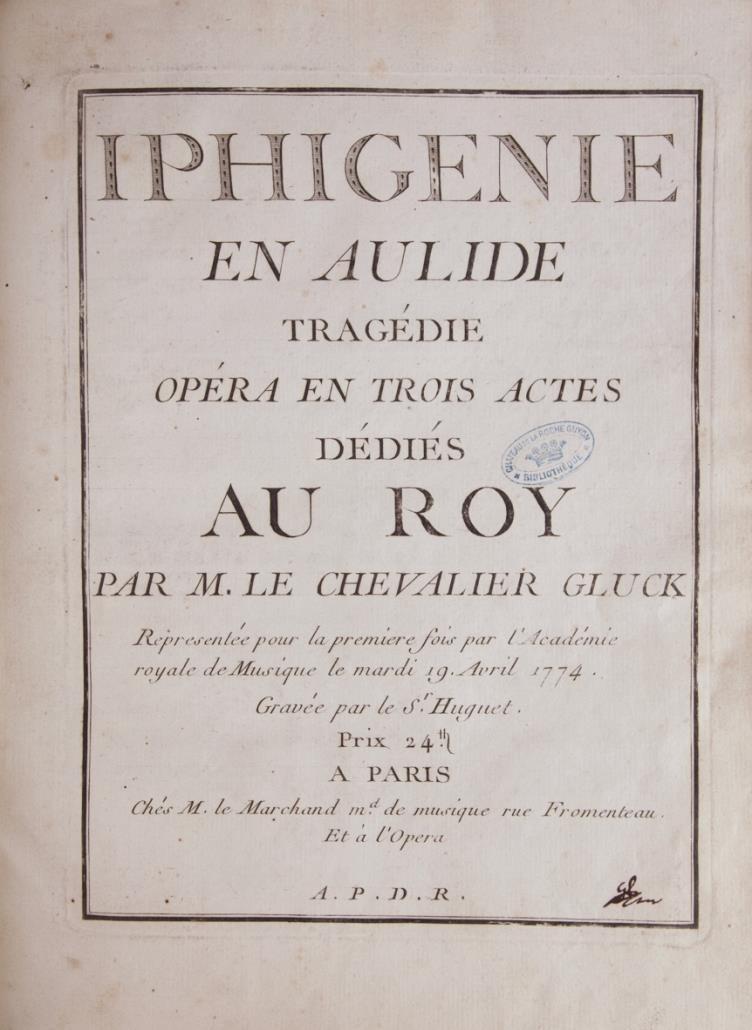
Unrecorded First Issue With Gluck’s Autograph Control Signature
12. GLUCK, Christoph Willibald 1714-1787
Iphigenie en Aulide. Tragédie Opéra en trois actes dédiés au Roy ... Representée pour la premiere fois par l'Académie royale de Musique le mardi 19. Avril 1774. Gravée par le Sr. Huguet. Prix 24th. ... A.P.D.R. [Full score]. Paris: Chés M. le Marchand md. de musique rue Fromenteau Et à l'Opera, [1774].
Folio. Full contemporary green vellum with dark red leather title label gilt to spine, all edges red, marbled endpapers. 1f. (recto title, verso blank), 1f. (recto composer's dedication to the King, verso blank), 298 pp. Engraved throughout. Preserved in a custom-made mid-tan linen clamshell box with mid-tan leather title label gilt to spine. Binding very slightly worn, rubbed, and warped. Occasional very minor signs of wear; several small stains; some corners very slightly creased; single very small binder's hole to upper margins; ca. 2 cm loss to blank edge of pp. 57/58; light to moderate browning to pp. 119-126, 227-230, and 263-266.
Early manuscript text added to pp. 238-241, repeating the sung text printed in other vocal parts.
With what is believed to be the composer's abbreviated autograph control signature to lower outer corner of title. The same signature appears on copies of this first issue held by the Morgan Library and Museum in New York City and by the Staatsbibliothek in Bamberg, Germany; the title page with signature of the Morgan Library copy is reproduced in Grove (6) vol. 7, p. 465. We have not located a copy of the present work at the Bibliothèque Nationale in Paris. We would like to thank Prof. Dr. Daniela Philippi and
her colleagues at the Gluck-Gesamtausgabe, Institut für Musikwissenschaft, Goethe-Universität, Frankfurt for advice regarding the Gluck signature.
Provenance
From the distinguished library of the Chateau de la Roche-Guyon, with their small oval handstamp to title. This famous library was largely dispersed by Sotheby's in Monaco in 1987.
A very attractive copy in original state.
First Edition, unrecorded first issue, with misspellings. Rare. See Hopkinson 40A. Wotquenne, pp. 21011. Lesure, p. 238. Sonneck Dramatic Music, p. 56. Hirsch II, 273. RISM G2747.
Iphigenie en Aulide, to a libretto by Marie François Louis Gand Leblanc, Bailli du Roullet (1716-1786) after the play by Jean Racine (1636-1699), itself after Euripides, was the first of Gluck's Paris operas; it premiered at the Opéra on 19 April 1774.
"Gluck and Roullet made careful preparations for their conquest of the Académie Royale de Musique, beginning by publishing open letters to one of its directors in the Mercure de France offering Iphigénie en Aulide for performance and outlining Gluck’s Italian operatic reforms and his intentions in Paris. But when they saw the score of Iphigénie en Aulide the directors of the Académie Royale were reluctant to mount a production of the opera unless Gluck undertook to write five more for them, because they feared that the work’s boldness and originality would drive all the existing French operas off the stage. As resilient as ever, Gluck enlisted the support of the French dauphine, his former singing pupil in Vienna, Marie Antoinette, and he eventually arrived in Paris towards the end of 1773 to begin rehearsals for Iphigénie en Aulide ... The première of Iphigénie en Aulide in April 1774 was a triumph, but the run of performances was interrupted by the death of Louis XV a month later." Jeremy Hayes in Grove Music Online (40361)
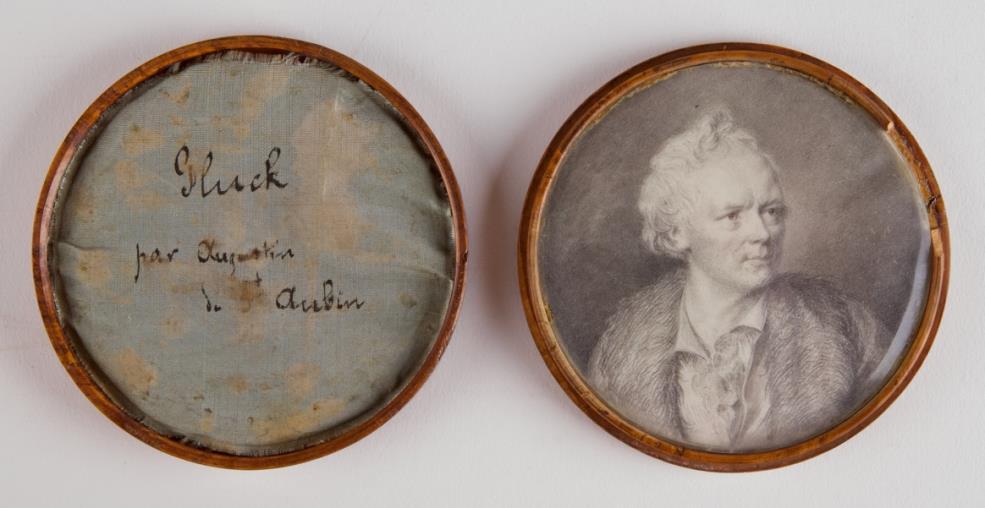
Original
13. [GLUCK, Christoph Willibald 1714-1787]
$12,000
Fine original miniature portrait in pencil on paper by Augustin de Saint Aubin (1736-1807). Ca. 17701780.
Housed in a circular screw-thread wooden maple box. 80 mm. in diameter, under glass, the upper portion lined in silk with an early ink inscription "Gluck par Augustin de St. Aubin." The composer is depicted half-length, facing forward with his head turned left, wearing a fur-lined coat and open collared ruffled shirt, without a wig. Small area of thread on wooden case lacking.
Provenance
Sotheby's London Music Sale 19 May 2006, Lot 63.
A rather delicate and insightful portrait, resembling the well-known Houdon portrait but apparently not based on it.
Saint-Aubin was one of the foremost French portrait engravers and book illustrators in the time of Louis XVI. He executed an engraving of Gluck in profile published in 1781 in addition to engravings of other musicians including Jean-Philippe Rameau, Jean Monnet, Jean-Joseph Cassanéa de Mondonville, JeanBaptiste Lully, Pierre Jeliote, andFrançois-Andre DanicanPhilidor. See StephenA. Bergquist: The Musical Portraits of Augustin de Saint-Aubin in Music in Art in the International Journal for Music Iconography Vol. XLII, nos. 1-2, pp. 255-271.
"Force of circumstance may have led Gluck to Paris to complete his operatic career, but in artistic terms Paris can be seen as his inevitable final destination. His years of grounding in opéra comique and the ballet and (via Traetta) his response to the French tragédie lyrique tradition had already provided the impetus for his overhaul of the opera seria; now it was time to confront that tradition on its own territory. On more than one occasion, indeed, Gluck explicitly owned the French influence, and its particular effect on his preparation for Paris. Between them the eight operas that he produced for the Académie Royale de Musique in Paris – the two Iphigénie operas; the radical revisions for Paris of the Vienna ‘reform’ operas Orfeo and Alceste; the similar revisions of the Vienna opéras comiques Cythère assiégée and L’arbre enchanté; Armide, a new opera on a libretto that Quinault had written for Lully more than 90 years earlier; and the last opera, Echo et Narcisse – are all different attempts at the confrontation and revival of that lyric tradition.
The French finale of Gluck’s career amounts, in truth, to an act of reform as thoroughgoing as any he had achieved in Vienna. It could be said that the impact he made in Paris, after a difficult initial period marked by open hostility, was more widespread, and its consequences were longer-lasting. There could be no question of any lack of sympathy with the dramatic possibilities of the tragédie lyrique form; its potential for long-lined, through-composed, dramatically integrated structures could only have proved thoroughly congenial to his mature tastes and capacities. ... His task was to convert the Paris Opéra from (in Rushton’s words) ‘a museum into a place of musical novelty and dramatic vitality’; and in successfully accomplishing it he simultaneously brought about the renewal of the tragédie lyrique tradition. ... In Paris, Gluck established the composer as driving force in the creation of any opera." Max Loppert in Grove Music Online (40423)
$5,500

Original Oil Painting of the Composer
14 [GLUCK, Christoph Willibald 1714-1787]
Original portrait painting after the well known painting by Étienne Aubry (1745-1781) held at the Louvre in Paris. Oil on board. Unsigned. [?]Paris, 19th century.
61 x 47.3 cms, with frame 69.5 x 56 cms.
The composer is depicted bust-length, turned 3/4 left, facing forward, wearing a red jacket, blue waistcoat, white collared blouse with lace, and wig. For a fine full-page color illustration of the original held at the Louvre, see MGG Vol. 5, plate 15. (40422) $2,500
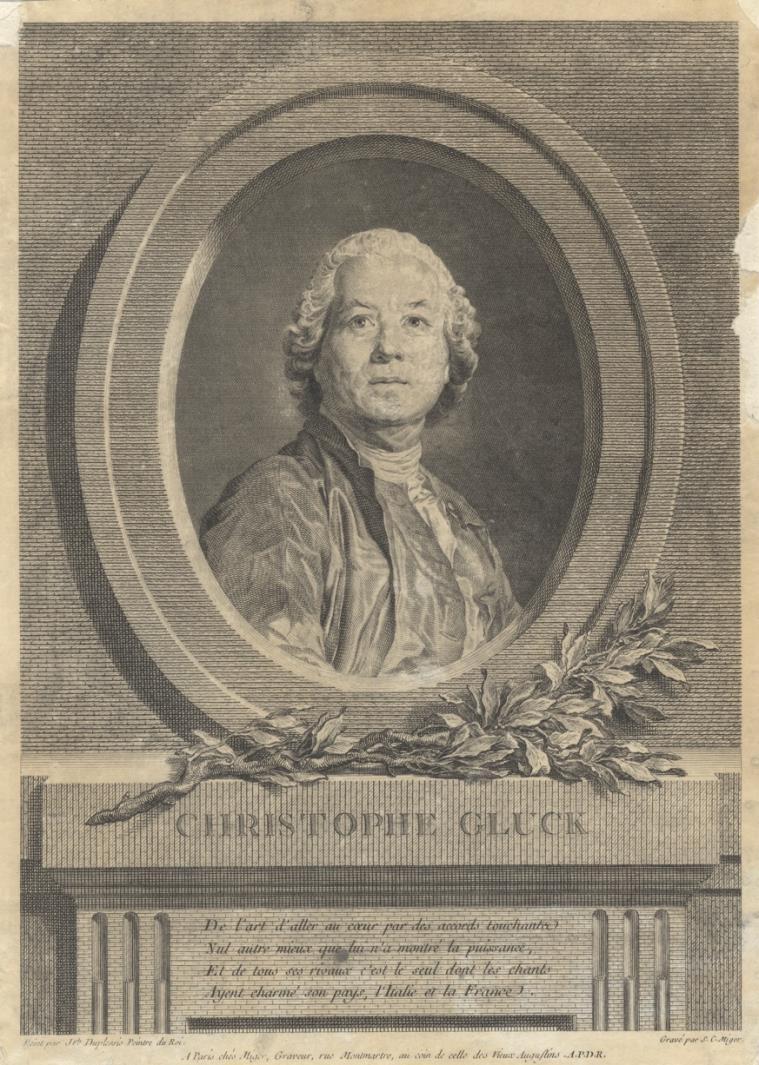
Lifetime Engraving
15 [GLUCK, Christoph Willibald 1714-1787]
Portrait engraving of Christoph Gluck by Simon Charles Miger (1736-1820). After the well-known painting by Joseph Siffred Duplessis (1725-1802). Paris: Chés Miger. Ca. 1775.
Sheet size 284 x 204 mm. The composer is depicted in a circular frame, one-third length, turned left, with head facing forward and eyes raised. He is dressed in a pleated coat, waist-length jacket, shirt, and cravat. The circular frame sits on a stone shelf and is adorned with a branch of laurel, with lettering below as follows: CHRISTOPHE GLUCK // De l'art d'aller au coeur par des accords touchants [letzter Buchstabe verdruckt] / Nul autre mieux que lui n'a montré la puissance, / Et de tous ses rivaux c'est le seul dont les chants / Ayentcharmé son pays, l'Italieet la France."Slight browning;minor abrasions primarily to margins with minor paper loss; some paper repairs.
Scarce. (40412)
$600
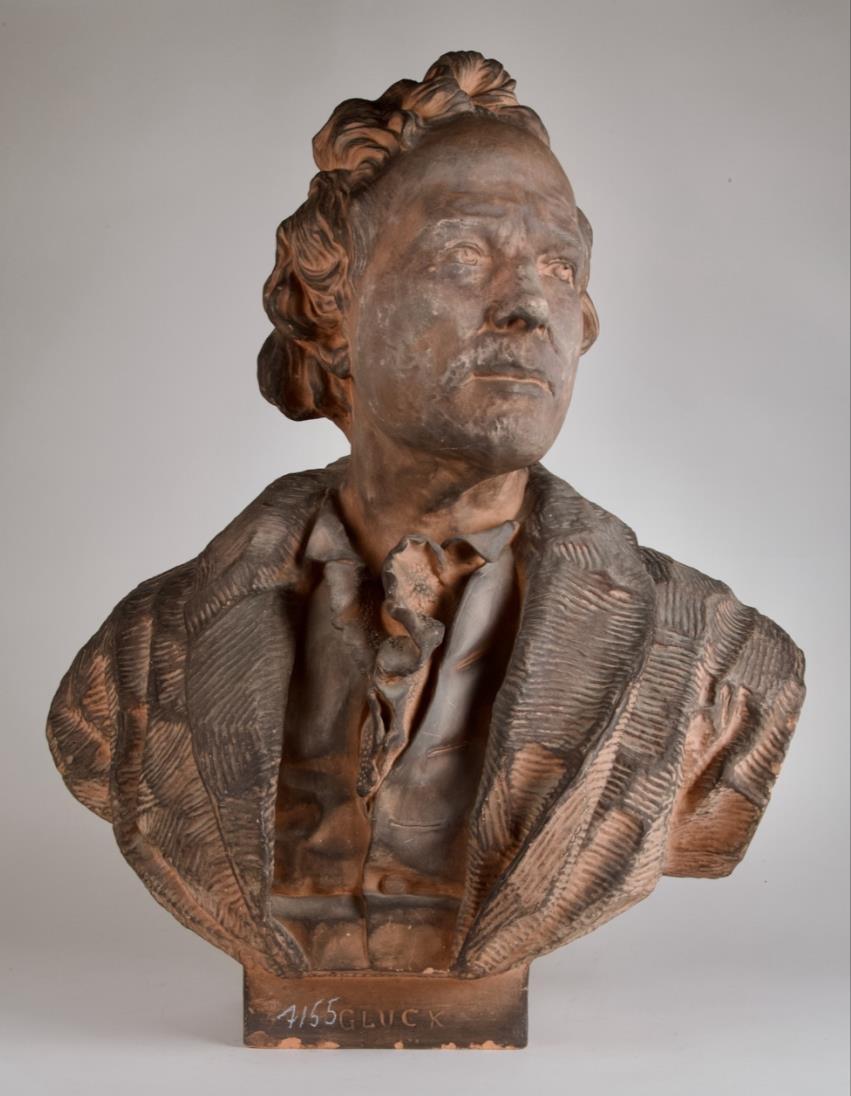
Scarce Terracotta Bust
16 [GLUCK, Christoph Willibald Ritter von 1714-1787]. Houdon, Jean-Antoine 1741-1828
Portrait bust sculpture in terracotta of the composer, head and full shoulders, head turned left. After the marble bust by Guillaume Francin (1741-1830), brother-in law of Houdon, and the original plaster by Houdon of 1775. Ca. 1864.
Height 26.75" (68 cms). With the artist's name ("Francin") to truncation of left arm; integral base inscribed "Gluck." Some wear and soiling; age-toned. In quite good condition overall.
Provenance
Catalogue of the Collection Musicale André Meyer (1961), Vol. I, p. 97 and plate 122. Auction catalogue of Pescheteau-Badin, Godeau et Leroy, Collection Musicale André Meyer et a divers, Paris, July 2, 1998, Lot 101, including color photograph. Auction catalogue of Bonhams London, The Roy Davids Collection, London 3 October, 2005, Lot 246, illustrated.
Houdon: An Exhibition of Sculpture from the Collection of Michael Hall, esq. Catalogue by Christine Defazio, Karl Fugelso, and Philip Mezzatesta. New York: Salander-O'Reilly Galleries, 1998 pp. 12-15. Poulet et al.: Jean-Antoine Houdon - Sculptor of the Enlightenment. Exhibition Catalogue. The National GalleryofArt,Washington,D.C.,2003,pp.102-108. Exposition du Centenaire de Houdon, Paris:Galleries Buvelot, 1928, pp. 40-41. Vitry: Une Liste d'oeuvres de J.-A. Houdon, p. 9.
The present sculpture exists in two versions: the present, scarcer, version with full shoulders and partial torso and a second version with partial shoulders and reduced torso
"Following Houdon's plaster bust of Gluck shown in the Salon of 1775 ..., the marble was exhibited in 1777 ... and destroyed in the fire at the Paris Opera , 28-29 Oct. 1873. A faithful reproduction, ordered in 1798 by Alexandre Lenoir for the Musée des monuments français and executed in marble by Guillaume Francin, is in the Musée national du chateau de Versailles. The Louvre's plaster cast workshop distributed copies of this reproduction beginning in 1864." Poulet et al.: Jean-Antoine Houdon - Sculptor of the Enlightenment. Exhibition Catalogue. The National Gallery of Art, Washington, D.C., 2003, p. 107.
"The present bust is probably one of [the Louvre's copies]. ... It was in his depiction of Gluck that Houdon first showed the ravages of smallpox on a subject - it was a common affliction in eighteenth-century France but artists were expected to flatter their subjects in this respect at least." Bonhams catalogue
"Gluck was an artist, a great musician, and therefore must be given the attributes of a genius. His face was deeply pockmarked, and the sculptor used this fact to establish his theme. He clothed him in a heavy coat, whose texture is an overall pattern of slashed grooves, free and direct in their expressive impact. Here there was no attempt to stimulate the appearance of the actual material, but rather, in a manner almost Rodinesque, to bring out the quality of the clay. The open shirt, the unbuttoned vest, the short, disheveled hair, and the alert, titled pose of the head all emphasize the impact of genius." Arnason: The Sculptures of Houdon, p. 34. (40417) $6,000
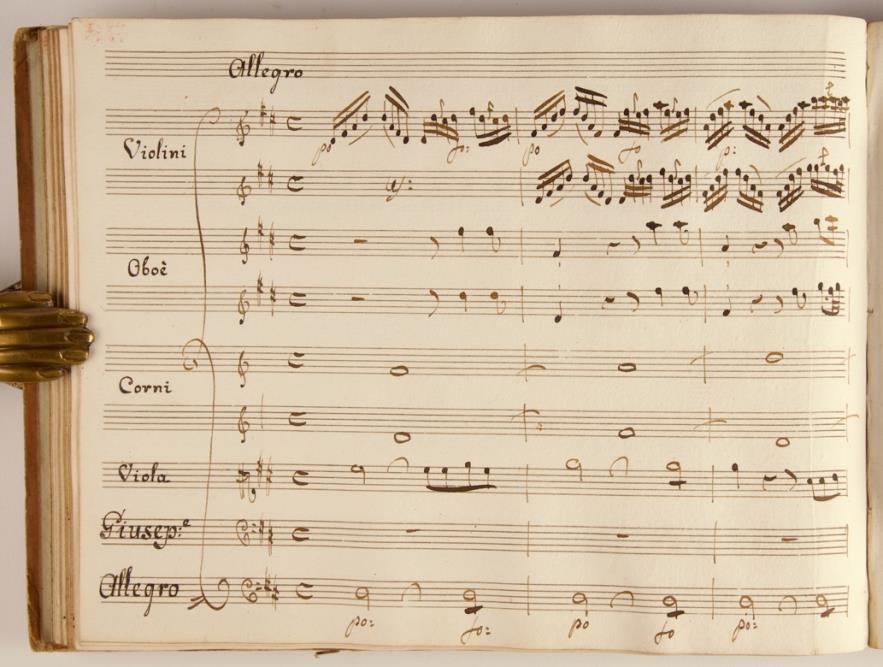
Copyist Manuscript Full Score of Jommelli's Celebrated Work
17. JOMMELLI, Niccolo 1714-1774
La Passione del N.S.G.C. [Nostro Signore Gesù Christo] Oratorio a 4. Voci Con Violini, Viole, Oboè, Corni, e Bassi ... Parte Prima [-Seconda] Proprio di Giuseppe Cecchi. [Copyist manuscript full score]. Italy. Ca. 1770-1790.
Oblong quarto (214 x 266 mm). Two volumes. Early mid-tan paper boards with light red and dark brown title and "10" labels to spine in gilt-ruled compartments. Notated in black and brown ink on 10-stave rastrum-ruled paper. Watermark of the letters "F G" within a shield. Bindings worn, rubbed, and bumped; minor loss to labels to Vol. 1, labels to Vol. 2 mostly lacking.
Scored for four voices, strings, oboes, and horns and set to text by Pietro Metastasio (1698-1782). In two parts: Parte prima: [i] (title), 206 pp.; parte seconda: [i] (title), 176, [i] (blank) pp. One cancellation.
First published in London by Robert Bremner in 1770.
Jommelli, an Italian composer, "was important among those who initiated the mid-18th-century modifications to singer-dominated Italian opera. His greatest achievements represent a combination of German complexity, French decorative elements and Italian brio, welded together by an extraordinary gift for dramatic effectiveness. ...
In the early 1750s Jommelli’s work gravitated towards sacred music, beginning with the oratorio La passione di Gesù Cristo, composed in Rome in 1749. The composer dedicated this work to Cardinal Heinrich Benedict, Duke of York, who had been his patron for many years. This gained him entrance to influential papal circles, where he met Cardinal Albani. In the first days of April 1749 the prefect of music in the Vatican, Monsignor Passionei, commissioned Jommelli and another Neapolitan composer, David Perez, to write a Miserere as a demonstration of their capabilities. Backed by Cardinal Albani and Passionei, Jommelli was then elected maestro coadiutore of S Pietro with a decree issued on 20 April. The decree asserted that he must be in Rome for the beginning of the Holy Jubilee Year of 1750 and follow indispensably the year-round service in the basilica. ... At the time of his death, Jommelli was regarded as one of the greatest composers of his time. He was always among those cited when memorable composers of the century were named. In Stuttgart, Schubart declared:The greatest musical Pan is dead … If richness of thought, glittering fantasy, inexhaustible melody, heavenly harmony, deep understanding of all instruments, and particularly the full magical strength of the human voice – if great art affects entirely each chord of the human heart, if all these – yet combined with the sharpest understanding of musical poetry –constitute a musical genius, then in him Europe has lost its greatest composer.
In De la musique en Italie Aleksandr Beloselsky wrote that Jommelli could ‘be regarded universally as the most profound and the greatest artist who has ever distinguished himself in the harmonious profession’. Arteaga described him as ‘truly original in having such excellent qualities as the felicity of his musical imagination, which earned him the appellation of the Chiabrera, and the Horace of composers, the coupling of expression and difficulty, the richness, and the energy and vivacity of his scoring’." Marita P. McClymonds, Paul Cauthen, Wolfgang Hochstein, and Mauricio Dottori in Grove Music Online
Former owner Giuseppe Cecchi was, in all likelihood, the Abbé Giuseppe Cecchi, possibly a near-relative of Dominique Cecchi, a famous singer at the end of the 17th century. Both the Bodleian Library and the British Library hold manuscripts in Giuseppe Cecchi's hand.
The full score of Jommelli's celebrated, career-defining work, rendered in an accomplished professional copyist's hand, perhaps that of Giuseppe Cecchi (40269) $1,200

One of the Most Significant and Beautifully Engraved Harpsichord Publications of the 18th Century
18. MUFFAT, Gottlieb Theophil 1690-1770
Componimenti Musicali per il Cembalo di Theofilo Muffat Organista di Corte e Camera di Sua Sacra, Cesarea, Cattolica, e Real Maestà Carlo VI Imperatore Di Sua Maestà L'Imperadrice Amalia Vedova e Maestro di Cembalo D'Ambidue Le Serenissime Arci-Duchesse Regnanti e Parmente di Sua Altezza Reale Duca di Lorena E Gran Duca di Toscana. Scolpit in rame et fatti Stampare Da Giovanni Christiano Leopold ntagliatore in Augusta. Con Gratia e Privileggio di sua Sacra Cesarea Cattolica e Real Maesta. Augsburg: J. C. Leopold, [ca. 1739].
Oblong folio. Full contemporary mid-tan calf with coat of arms of Charles VI of Austria, the Holy Roman Emperorand dedicatee of thework incorporating two eagles andacrownto both boardsgilt, with additional decorative gilt tooling to edges, spine in decorative compartments gilt, marbled endpapers, red edges. 1f. (recto fine decorative title engraved by J.A. Fridrich, versoblank), 1f. (recto dedication to Charles VI, verso blank), 1f. recto dedication, verso blank), 1f. (recto composer's notes on ornamentation, notation, and titles of pieces, verso "Al Benigno Lettore"), 1f. (typeset "An den geneigten Leser"), 105, [i] (blank) pp., 1f. (recto table of ornaments, verso blank) pp. Title, dedication, composer's notes, music, and ornament table engraved.
The elaborate engraved title by the important German engraver Jacob Andreas Fridrich the Elder (1684-1751) features putti holding a draped border with titling within; Apollo with his lyre; a satyr playing apanpipe;puttiplayingbagpipes,shawn,hurdy-gurdy,violin,cello,recorder,andguitar;additionalmusical
instruments including lutes, bassoon, trumpets, and horn; St. Cecilia seated at a harpsichord, holding a quill and dipping it in an inkwell; musical scores; trees, shrubs, and clouds. The border is topped with a crowned eagle holding a sword and scepter.
Provenance
A distinguished line of ownership:
- Charles VI of Austria (1685-1740), to whom this work is dedicated
- Julian Marshall (1836-1903), noted British music collector, with his decorative bookplate to front pastedown
- James E. Matthew (1838-1917), noted English collector, with his decorative bookplate to blank preliminary leaf
- Dr. Werner Wolffheim (1877-1930), important German music collector and bibliographer, with his small handstamp to lower margin of blank preliminary leaf
- André Meyer (1884-1974), noted French music collector, with a manuscript note in blue ink to blank verso of finalleaf of music and handstamp "Provenant de la Collection d'André Meyer Décédéen Mai1874 F. Meyer Octobre 84" to verso of blank rear leaf Sotheby's Paris 16-17 October, 2012, "De La Collection Musicale André Meyer," lot 220
With a single loose leaf laid in, recto Catalogus der jenigen musicalischen Wercke, so bey Ioh. Christ Leopold Kunst-Verlegern in Augsburg, um nachgeszten äfsersten Preiss zu haben seÿnd, verso blank. The final entry in the catalogue is the present work; the catalogue also includes the collection of harpsichord suites Musicalischer Parnassus by Johann Kaspar Ferdinand Fischer (1656-1746). There is a manuscript note,possiblyin eitherMarshall'sorMatthews'shand,ininktoblankuppermarginstating"This listappears in the ordinary copies." Binding worn, rubbed, bumped, and warped; joints partially split; small paper label to upper outer corner of front pastedown; front and rear free marbled endpapers lacking. Occasional minor signs of wear; preliminary leaf browned at margins with minor red stain; some light soiling and foxing; the single leaf "Catalogus" browned and foxed, with small tears to edges. A very attractive, wide-margined copy overall.
First Edition. Rare. BUC, p. 716. Wolffheim I, 1427. Weckerlin, p. 482. RISM M8134 and MM8134 (three copies only in the U.S., at the Library of Congress, the University of Rochester, and Harvard). One copy only recorded at auction by Rare Book Hub in over 75 years.
Fraenkel: Decorative Music Titlepages, 141. Schaal: Musiktitel aus fünf Jahrhunderten, 88. Zur Western: Musiktitel aus vier Jahrhunderten, pp. 57-58, plate 50.
Muffat, a German composer and organist, "was the leading keyboard composer in Vienna in the early 18th century. ... Unlike his versatile father [Georg Muffat], Muffat chose to restrict himself almost exclusively to one field, that of keyboard music. He came at the end of a long line of Baroque organists and keyboard composers working in Vienna and was the only contemporary of Bach there to make a substantial contribution to the keyboard repertory in both quantity and quality. Much of his music remained unpublished and is still not generally known: it covers a wider range of forms than the two published collections alone would suggest. Although he lived until 1770, he belongs musically to the late Baroque period rather than to the age of Haydn; his keyboard works never desert traditional Baroque structures (toccata, complete fugue, dance suite, ciaccona)." Susan Wollenberg in Grove Music Online
“Of Handel's German contemporaries, besides Bach, both Johann Mattheson (1681-1764) and Gottlieb Muffat (1690-1770) ... wrote suites for the harpsichord. ... Muffat's Componimenti ... have considerably more character [than Mattheson's suites]. Handel thought sufficiently well of them to borrow extensively from them. ... Muffat's suites combine a German richness and solidity of texture with a melodiousness that sometimes suggests Italian influence. They all include a substantial number of movements, some of which
have fanciful titles such as "'La Hardiesse' and 'La Coquette'. ... There is a considerable variety of style in Muffat's work. Sometimes we seem almost to be in the world of Haydn. ... At other times, particularly in the sarabandes, there is a wealth of intimate detail which recalls the keyboard music of Bach. ... The courantes are mostly of the Italian type, with many rapid passages. On the other hand several of the opening movements of the first suite have stately introductions in the style of the French overture. The six suites are followed by a chaconne in G major with variations, similar to Handel's two and certainly superior to his second and longer example. Muffat wa, like Handel, thoroughly cosmopolitan. His fugues are not as compelling as those in Handel's suites, but in general the texture is more substantial and more varied." Abraham, ed.: New Oxford History of Music Volume VI, pp. 620-623.
The highly attractive title is a fine example of the influence of the French Rococo on graphic artists of Augsburg, an important center for graphic art at the time.
One of the most significant and beautifully engraved harpsichord publications of the 18th century (40421) $12,000
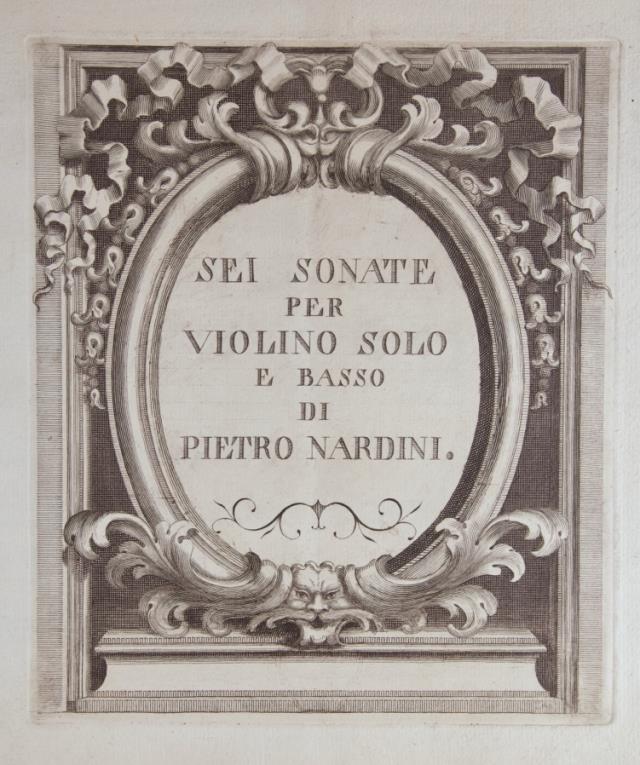
Highly Attractive Large Format Copy
19. NARDINI, Pietro 1722-1793
Sei Sonate per Violino Solo e Basso. [Op. 2]. [Sonatas forviolin and basso continuo]. [?]Italy: n.p., n.d. Ca. 1765.
Large oblong folio. Modern ivory paper boards with printed titling to upper. 1f. (recto blank, verso halflength engraved portrait), 1f. (recto fine decorative engraved title, verso blank), 29 pp. + 6 integral blank pp. Watermark "A.F." Engraved throughout The fine half-length engraved portrait of Nardini by G.
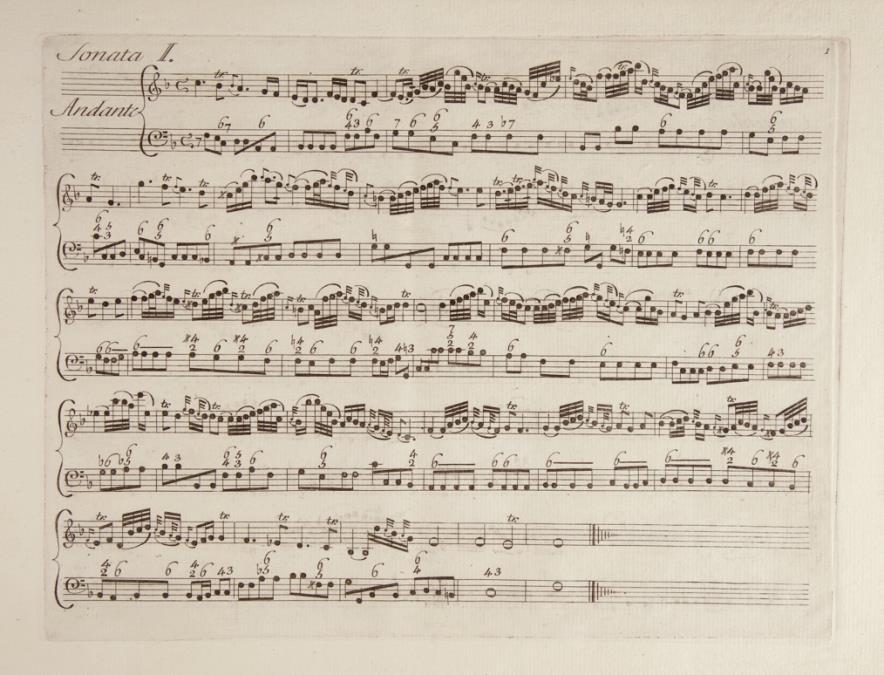
Batt[ist]a Cecchi after Marco Vestri depicts the composer holding a piece of sheet music. Slightly worn; occasional minor stains and soiling; minor worming to inner blank margins of several leaves; two small pinholes to blank inner margin of final three leaves; minor loss to blank outer margin of final leaf; each leaf carefully guarded at gutter and tipped onto binder's paper at blank inner margins.
Provenance
The André Meyer Collection, Paris, with his handstamp to blank verso of final leaf: "Provenant de la collection musicale d'André Meyer Décédé en Mai 1974 F. Meyer Octobre 84" and manuscript attestation to verso of free rear endpaper dated June 1980 confirming that the present volume was part of the Meyer collection sold by Sotheby's Paris on 16-17 October 2012, lot 229.
Possible First Edition. Rare. Lesure (one copy only, in France). Collection Musicale André Meyer I, p. 54. BUC, p. 724. RISM N45 (two copies only in the U.S., at U.C. Berkeley and the Library of Congress).
Nardini was a noted Italian violinist and composer. "He displayed an early musical talent and received his first lessons in the town of his birth. In 1734 he was accepted as a pupil of Tartini in Padua and soon became his favourite student (according to Leoni and Burney). He then undertook an intensive programme of teaching and giving public and private concerts, for which he often went abroad for long periods. In 1760 he was in Vienna at the wedding festivities of the crown prince; from October 1762 until March 1765 he served at the court in Stuttgart under the direction of Jommelli, returning to his own country only for short visits; in 1765 he went to Brunswick, and in May 1766 he returned to Livorno. Two years later he was appointed solo violinist, and later music director, at the chapel of the court of the Grand Duke Leopold of Tuscany in Florence, where he remained until his death. The Florentine orchestra was made up of eminent musicians, including Campioni and Dôthel, who helped raise the musical and cultural level of the town: Nardini, for example, was a close friend of the poet Corilla Olimpica-Maddalena Morelli, and was himself a member of the Arcadia under the name of Terpandro Lacedemone. His one absence from Florence was during Tartini's final illness, when, according to Burney, he cared for the dying maestro with true filial affection and tenderness.
Nardini was famed not only for his orchestral playing but also for his solo performances, which he gave until the 1790s. He performed at the court of Ferdinand III of Bourbons in Naples, in Rome at the Gonzaga residence and in Pisa in the presence of Emperor Joseph II in 1784. His compositions reflect his abilities as a performer. He was noted for his perfect technique, excellent bow control and a superb sound. Leopold Mozart heard him play in 1763 and remarked: ‘The beauty, purity and evenness of his tone and his cantabile
cannot be surpassed’. He was particularly famed for his performance of adagio movements, which were more suited to his lyrical rather than dramatic nature. According to Schubart, he managed to move even the most insensitive listeners by the deep emotions expressed so effortlessly and naturally. His compositions, accordingly, combine two traits typical of the Italian style in the 18th century: cantabile and passionate writing in slow movements and fluency in fast ones.
It is difficult to establish a chronology of Nardini's works, which include larger-scale works and chamber music for flute, strings and harpsichord. Stylistically they seem to fall into three main periods. 12 violin sonatas and four violin concertos, all unpublished, and the six sonatas op. 5 and concertos op. 1 date from about 1760. The overtures, harpsichord sonatas and Adagios brodés were composed about 1765–6, while the six quartets, other violin sonatas and the flute concertos were written after 1770. The sonatas show the influence of Corelli and Tartini, and mainly follow the sequence slow–fast–fast. The tonality remains the same for all three movements, which normally have a bipartite structure. The first allegro is often bithematic and the most developed, whereas the last movement is usually a dance, rondo or set of variations. The adagio movements, which are generally in free form, are the most lyrical.
Nardini's disciples included Gaetano Brunetti, Cambini, Campagnoli, Giulini, Gozzi, Lucchesi and Manfredi in Italy and Joseph Agus, Thomas Linley (ii), Pichl and F.W. Rust abroad." Maria Teresa Dellaborra in Grove Music Online
Exquisitely printed engraved music by a celebrated 18th century master of the violin, on fine paper in an unusually large format with wide margins. (40360) $1,500
15th Century Leaf Depicting Tubal Playing a Portative Organ
20. [ORGAN]. Schedel, Hartmann 1440-1514
Liber Chronicarum [The Nuremberg Chronicle]. A single leaf (Blat X) from the section entitled "Das erst alter der werlt." Nuremberg, 1493.
1 leaf. Large folio (436 x 305 mm). Extracted from one ofthe most famous incunabula, with early coloring. Text in German. With a number of woodcut figures, including that of the character Tubal, who is depicted playing a portative organ with one hand while working the bellows with the other. Some minor wear and soiling but in quite good condition overall. The Biblical figure, Tubal, son of Japeth, himself the son of Noah, is considered to be the father of the Caucasian Iberians, ancestors of the Georgians.
"The Liber Chronicarum by Hartmann Schedel printed in Nuremberg by Anton Koberger in 1493, or Nuremberg Chronicle as it is generally called, is one of the most important German incunables and the most extensively illustrated book of the 15th century.
The text is a universal history of the Christian world from the beginning of times to the early 1490s, written in Latin by the Nuremberg physician and humanist Hartmann Schedel (1440-1514) on commission from the Nuremberg merchants Sebald Schreyer (1446-1520) and Sebastian Kammermeister (1446-1503). Drawn by the author from multiple medieval and Renaissance sources, such as Bede, Vincent of Beauvais, Martin of Tropau, Flavius Blondus, Bartolomeo Platina and Philippus de Bergamo (Iacopo Filippo Foresta), the Chronicle also incorporates geographical and historical information on European countries and towns. The narrative is divided into 11 parts, the so-called world ages, and is profusely illustrated by images of biblical and historical events, and topographical views of towns and countries in Europe and the Middle East, including Jerusalem (and its destruction) and Byzantium.
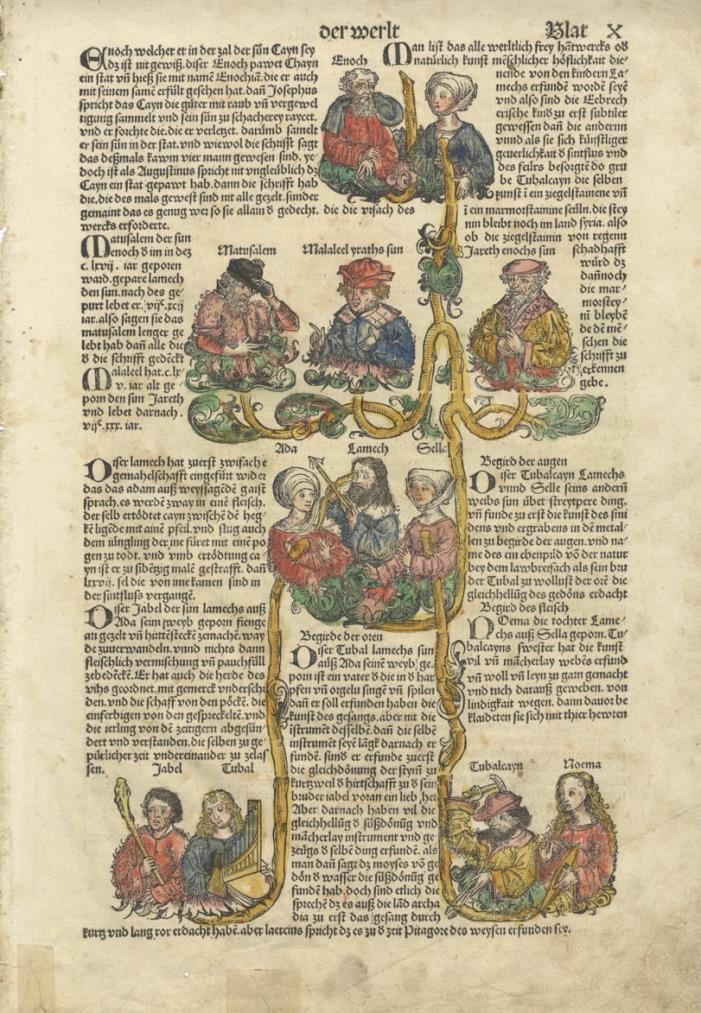
Schreyer and Kammermeister commissioned the printing of the Chronicle to the Nuremberg printer Anton Koberger (ca.1440-1513), owner of the largest 15th-century German printing house. The Latin edition was printed in Koberger's shop between May 1492 and October 1493. In the meantime, a German translation was commissioned by the two financiers to Georg Alt (circa 1450-1510), a scribe at Nuremberg treasury, and the German edition was printed alongside the Latin one between January and December 1493. The project was completed on 23 December 1493. Both editions are lavishly illustrated with 1804 xylographical images created from 641-643 woodblocks by the Nuremberg artists Michael Wolgemut (circa 1434/37 –1519) and Wilhelm Pleydenwurff (circa 1450 - 1494), a map of the world, showing the Gulf of Guinea discovered by the Portuguese in 1470, and a map of Northern and Central Europe by Hieronymus Münzer (circa 1437/1447 - 1508). The woodcut illustrations of a number of copies, both in Latin and in vernacular, were also supplied with hand colouring by contemporary German artists. The alleged involvement in the creation of the woodblocks of Albrecht Dürer (1471-1528), has now been rejected on the documentary evidence that he only worked as an apprentice in Wolgemut's workshop between 1486 and 1489, well before the beginning of the production of the Chronicle.
The beauty of the illustrative apparatus, the skilful production and the elegant mise-en-page of the both the Latin and German editions of the text account for the 'enduring value' of the Nuremberg Chronicle, which survives in circa 1240 copies of the Latin edition and in circa 1580 copies of the vernacular." University of Cambridge Digital Library Online. (40407) $150
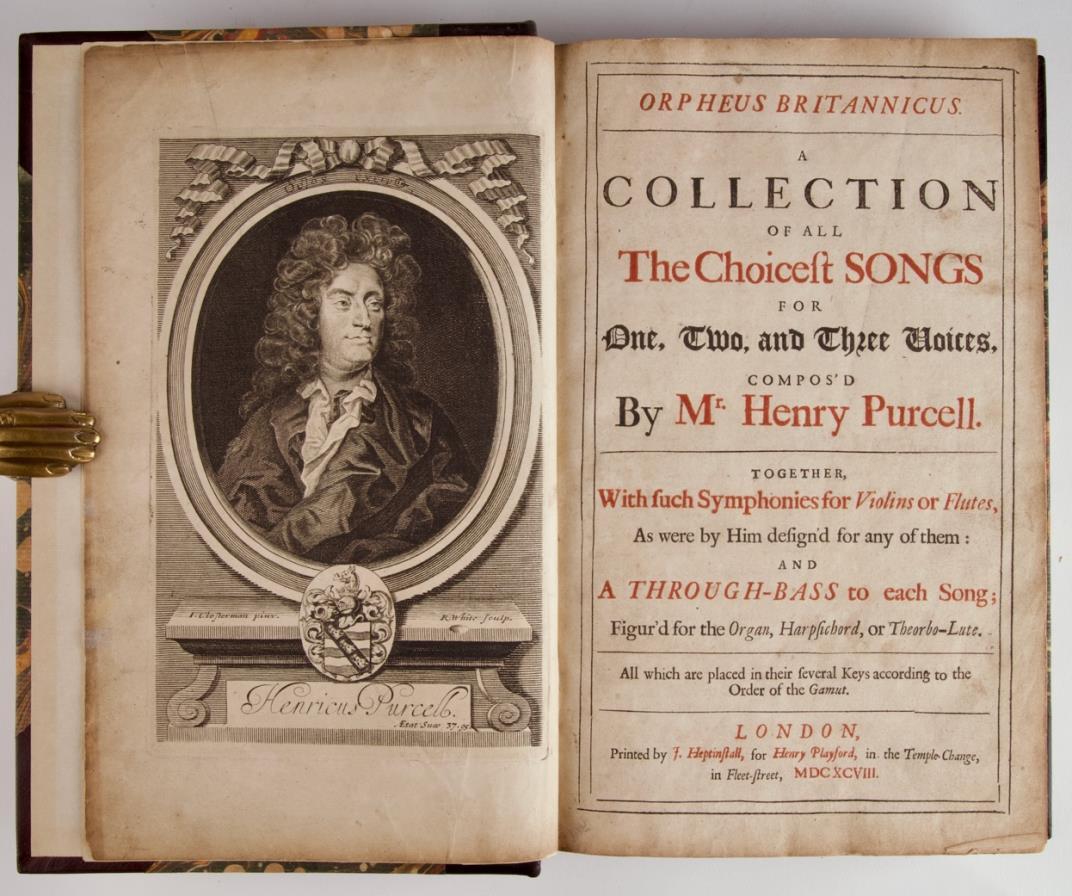
153 Songs by Purcell
21. PURCELL, Henry 1659-1695
Orpheus Britannicus. A Collection of All The Choicest Songs for One, Two, and Three Voices ... Together, With such Symphonies for Violins or Flutes, As were by Him design'd for any of them: And A Through-Bass to each Song; Figur'd for the Organ, Harpsichord, or Theorbo-Lute. All which are placed in their several Keys according to the Order of the Gamut ... Together with: Orpheus Britannicus ... The Second Book, which renders the First Compleat. London: J. Heptinstall, for Henry Playford, 1698, 1702.
2 volumes in one. Small folio. Attractively bound in modern half dark brown calf with marbled boards with blindstamped rules, raised bands on spine with decorative gilt-ruled compartments, titling gilt. Typeset. With a number of pictorial woodcut initials. Contains a total of 153 songs by Purcell.
Vol. I
1f. (recto blank, verso fine engraved portrait of Henry Purcell by R. White after I. Closterman), 1f. (recto title printed in red and black, verso blank), vi, (dedication, publisher's address to the reader, odes and tributes to Purcell), [ii] (table of songs, publisher's catalog), 248 pp. Contains 81 songs by Purcell. Slightly browned, heavier to some leaves, with occasional staining and minor foxing; trimmed, occasionally touching page numbers and with minor loss of printed area to foot of some pages, not affecting music; occasional marginal tears repaired; pp. 166-167 mispaginated. Early manuscript figured bass added to one measure, p. 219. First Edition. Zimmerman 1698d. Day & Murrie 166. BUC, p. 859. RISM P5979.
Bound with: Vol. II
William Pearson, for Henry Playford, 1702. 1f. (recto title printed in red and black, verso blank), 1f. (recto dedication, versoPlayford'saddresstothereader),ii("OntheDeathofthelateFamousMr.HenryPurcell"), [ii] (publisher's catalogue, table of songs), 32, 35-176 pp. Contains 72 songs by Purcell. Slightly browned and foxed, heavier to some leaves at margins; several marginal tears with repairs; pp. 84-85 and 171-174 mispaginated. Without the frontispiece portrait of Purcell (as is usual when both the first and second books are bound together). First Edition. Zimmerman 1702d. Day & Murrie 200. BUC, p. 859. RISM P5983.
Quite an attractive copy overall.
"Purcell was a prolific contributor to all the main genres of secular vocal music current in 17th-century England. He has always been particularly admired as a song composer. Generations of English musicians got to know his music from the two posthumous song volumes Orpheus Britannicus ... and Henry Playford wrote in the preface to the first volume that he had 'a peculiar Genius to express the energy of English Words, whereby he mov'd the Passions of all his Auditors', while Henry Hall added in a poem that he 'Each Syllable first weigh'd, or short, or long, / That it might too be Sense, as well as Song'." Peter Holman et al. in Grove Music Online. (40355)
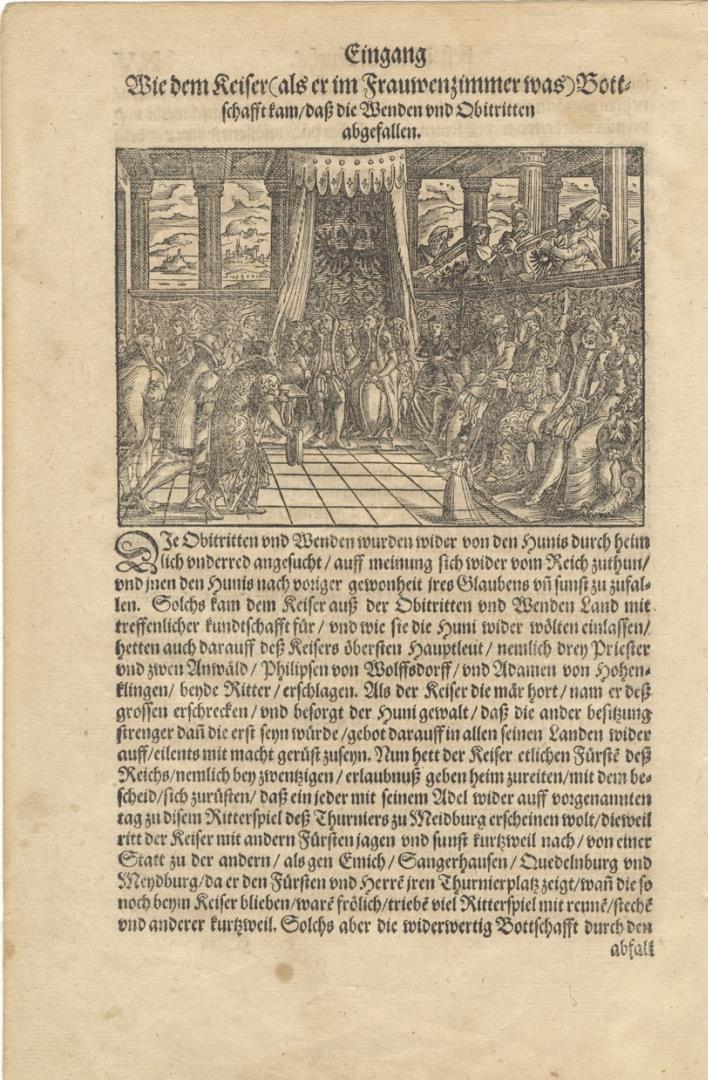
$2,500
16th Century Trumpet Iconography
22. [RENAISSANCE TRUMPET]
16th century wood engraving depicting trumpet players performing at a German court. [Franckfurt am Mayn]: [Georg Rab], [1566].
1 leaf. Small folio. Image size 105 x 148 mm; sheet size 306 x 198 mm. Extracted from Georg Rüxner's Thurnier-Buch von Anfang, Ursachen, Ursprung, und herkommen, der Thurnier im heyligen Römischen Reich Teutscher Nation. The scene depicts a King and Queen at court attended by various nobles, with three trumpet players performing from a low balcony above the court. Slightly browned. (40408)
$75
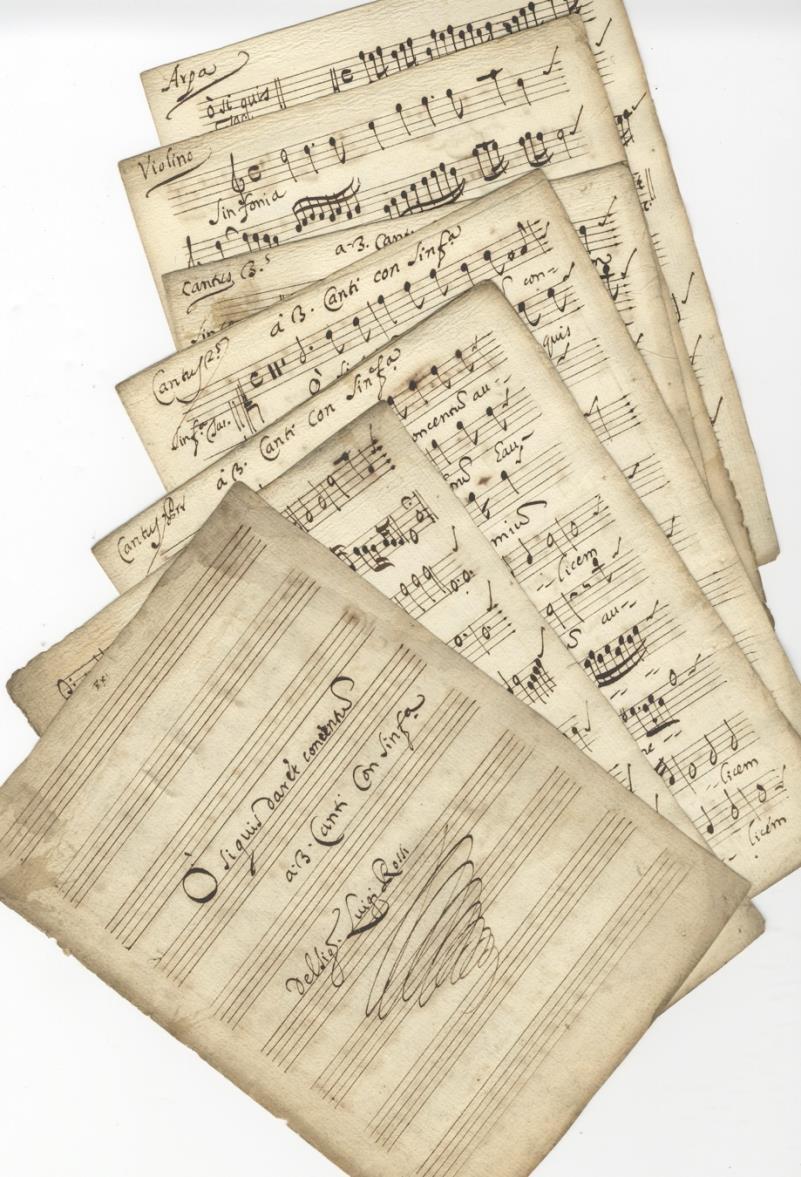
Manuscript of a Complete Early 17th Century Sacred Vocal Work
23. ROSSI, Luigi 1597-1653
Ò si quis daret concentum a. 3. Canti Con Sinfa. [Sacred motet for three voices, violin, harp, and organ]. [Manuscript set of parts]. Rome, [?]ca. 1640.
Quarto (164 x 224 mm.). Set of parts housed in a modern marbled ivory-backed presentation folders. Notated in black ink on 9-stave rastrum-ruled Italian paper with watermark fleur-de-lis within two circles. Outer diameter 43 mm. Not located in Briquet; resembles Heawood 1636. Slightly worn; light marginal soiling; occasional showthrough; title soiled and slightly stained; old paper tape obscuring small portion of final page of first voice part (easily removed by a conservator).
Organo: [i] (title), 2, [i] (blank) pp.; Cantus prs.: 4 pp.; Cantus 2s.: 4 pp.; Cantus 3s.: 4 pp.; Violino: 2 pp. ; Arpa: 2 pp.
No contemporary published edition located. Wotquenne: Étude bibliographique sur le compositeur Napolitan Luigi Rossi, p. (27), 221, recording one source only, held by the Fitzwilliam Museum, Department of Manuscripts and Printed Books, Cambridge, England. The work is found in a volume of "motets, dramatic scenes, etc. by Italian composers" in score format. Fuller-Maitland and Mann: Catalogue
of the Music in the Fitzwilliam Museum Cambridge, p. 17, 44, Folios 39v-46, dated 1704 in the catalogue and 171? in the Fitzwilliam online catalogue. We have not located any other source for the work and thus conclude that the present manuscript set of parts may, in fact, be the primary source.
Rossi, an Italian composer and keyboard player, "was active in Naples, Rome and Paris, and wrote some of the finest vocal music of the 17th century; his canzonettas and cantatas enjoyed wide popularity and he composed operas for both the papal family and the French royal court. ...
On 3 July 1627 Rossi married the Roman harpist Costanza de Ponte, who had been in the service of his patron's wife, Camilla Orsini. She, too, was one of the finest musicians of the time; in 1639 André Maugars described her as playing ‘parfaitement bien’ (Response faite à un curieux sur le sentiment de la musique d'Italie). Both husband and wife were much in demand: in 1635 Camilla recommended them to the dowager Grand Duchess of Tuscany, and the two visited the Medici court in Florence from May to November that year; Costanza described one of her performances there in a letter of 25 May (see Cametti, 1912–13). ... The theorist Severo Bonini, in his Discorsi e regole sopra la musica et il contrappunto (MS, 1649/50, ed. and trans. M. Bonino, Provo, UT, 1979), bracketed him with Francesco Cavalli as the ‘novelli cigni’ of Rome and Venice. Rossi's younger colleagues and successors also celebrated him as one of the leaders of Roman musical life." Robert R. Holzer in Grove Music Online
A complete sacred vocal work by Luigi Rossi, copied, in all likelihood, within the composer's lifetime, with the notable inclusion of a partfor harp; possibly composed for thecomposer's wife, Costanza de Ponte. (40274) $3,500
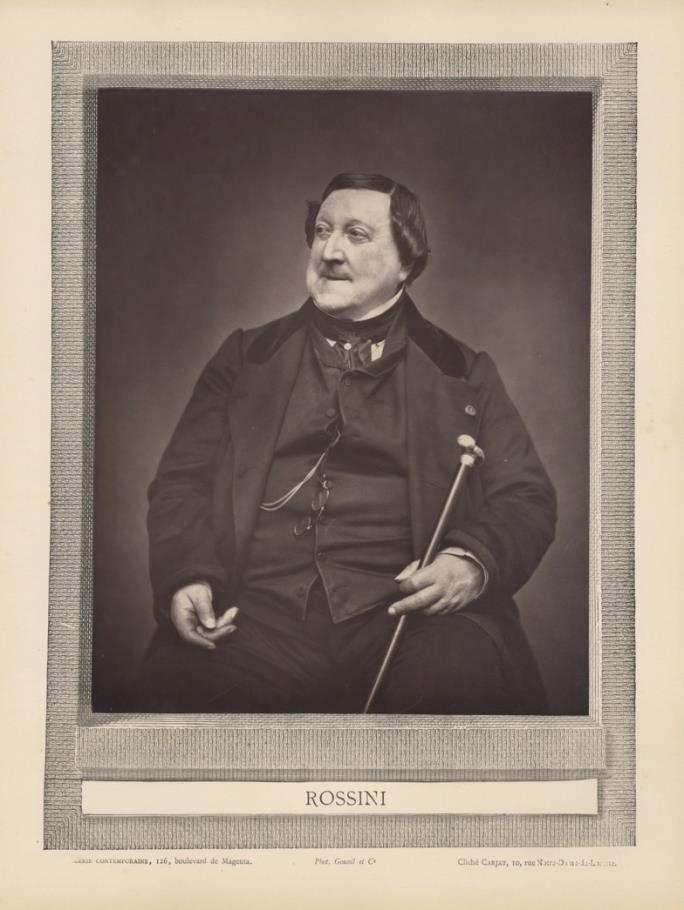
19th Century Carjat Photograph of Rossini
24. [ROSSINI, Gioachino 1792-1868]
Fine large woodburytype photograph of Rossini by French photographer Etienne Carjat. Goupil et Ce., [1876].
238 x 191 mm. Laid down to publisher's mat with decorative printed border. With 4-page bifolium containing historical text and facsimiles of an autograph letter and page of autograph manuscript score. The photograph is thoughtto date from1862. Published in the series Galerie Contemporaine, Vol. 3. Photograph in very good condition; text slightly worn and foxed.
"No composer in the first half of the 19th century enjoyed the measure of prestige, wealth, popular acclaim or artistic influence that belonged to Rossini. His contemporaries recognized him as the greatest Italian composer of his time. His achievements cast into oblivion the operatic world of Cimarosa and Paisiello, creating new standards
against which other composers were to be judged. That both Bellini and Donizetti carved out personal styles is undeniable; but they worked under Rossini's shadow, and their artistic personalities emerged in confrontation with his operas. Not until the advent of Verdi was Rossini replaced at the centre of Italian operatic life." Philip Gossett in Grove Music Online
Carjat (1828-1906) was a noted French photographer, caricaturist, and journalist, best-known for his numerous portraits of important Parisian figures. "The location of much of his photography is untraceable after being sold to a Mr. Roth in 1923." Wikipedia (40406) $350
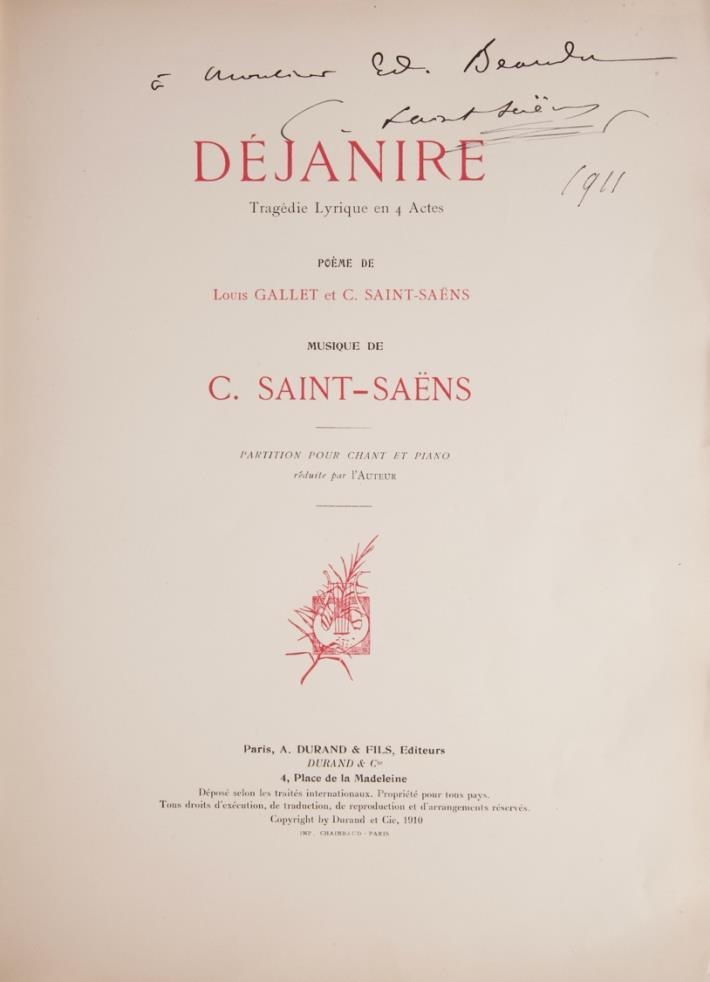
Signed by Saint-Saëns
25 SAINT-SAËNS, Camille 1835-1921
Déjanire Tragédie Lyrique en 4 Actes Poème de Louis Gallet et C. Saint-Saëns ... Partition pour Chant et Piano réduite par l'Auteur. [Piano-vocal score]. Paris: A. Durand & Fils ... 4, Place de la Madeleine [D. & F. 7747], [1910].
Quarto. Original publisher's ivory wrappers printed in red and black. 1f. (recto title printed in red and black, verso blank), 1f. (recto printed dedication to Fernand Castelbon de Beauxhostes, verso blank), 1f. (recto "Personnages" and notes on first performance printed in red and black), 1f. (recto Index, verso blank), 213, [i] (blank) pp. With "Ch. Douin gr. - Poinçons A. Durand & Cie" and "Imp. Chaimbaud & Cie." printed at foot of final page of music. In a custom-made half dark red morocco clamshell box with marbled boards, raised bands on spine in decorative compartments gilt with titling gilt. Two small stains to gutter of front endpapers; outer margin of leaf preceding title slightly browned; very small tear to blank outer margin of title repaired with archival tape to verso. Very light uniform browning; pp. 14-15 slightly browned from small blank leaf laid in; p. 34 browned; blank margins of final leaves slightly soiled. In very good condition overall.
A presentation copy, with the autograph signature of the composer ("C. Saint-Saëns") and date of 1911 to head of title. A number of pages with brief markings and annotations in lead pencil.
First Edition. Ratner II, p. 318.
"Saint-Saëns was asked to assume the editorship of the complete works of Rameau for Durand in 1894, and in 1896 was invited to help Castelbon de Beauxhostes in his restoration of the Arènes de Béziers and to
organize theatrical performances there. He composed incidental music for Louis Gallet's tragédie antique Déjanire, staged in 1898 with an orchestra that included the Garde Municipale of Barcelona, the Lyre Biterroise and 110 strings, 18 harps, 25 trumpets and choruses of more than 200; the audience of 10,000 came from all over France." Sabina Teller Ratner, James Harding, and Daniel M. Fallon in Grove Music Online
Revised in 1911, the work was first performed as a drame lyrique after Sophocles's Trachiniae in Monte Carlo on 14 March 1911. (40411) $500
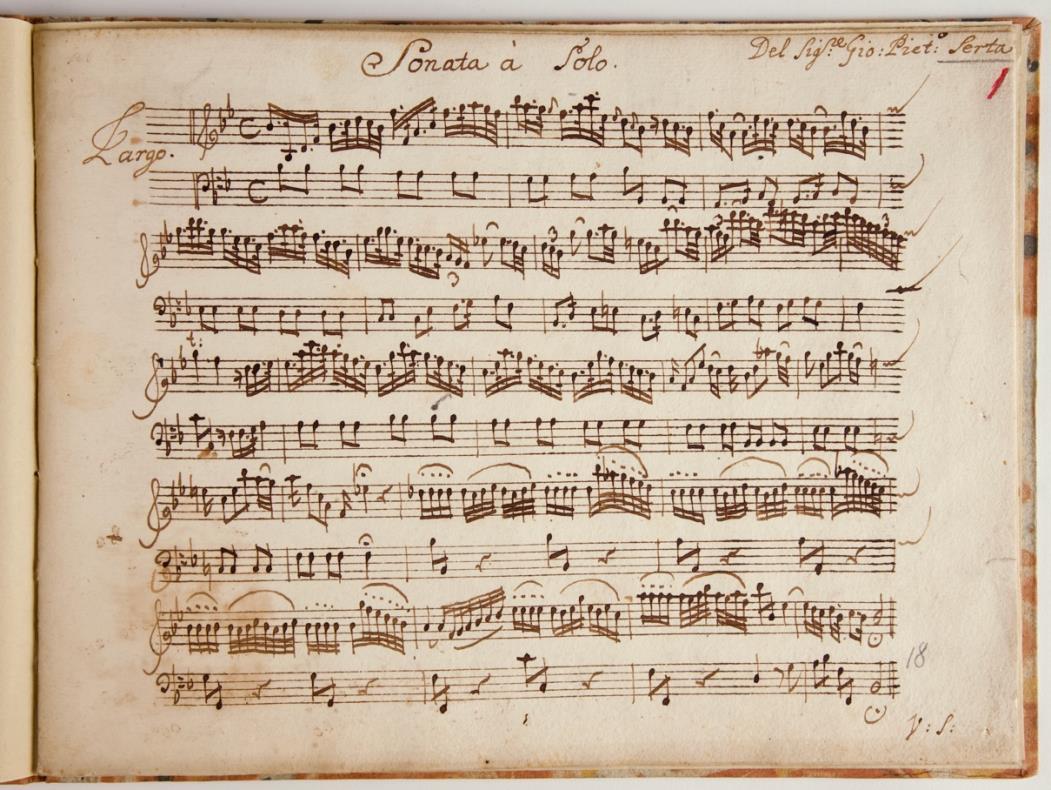
Unrecorded Early 18th Century Sonata for Violin and Basso Continuo
26. SERTA, Giovanni Pietro [Johann Petrus Virgil] ca. 1698-1729
Sonata à Solo. Del Sigre. Gio. Pieto. Serta. [Sonatas for violin and basso continuo]. [Musical manuscript]. [?]Salzburg. Ca. 1720.
Oblong quarto (225 x 282 mm). Modern marbled boards with manuscript title label to spine. 5, [iii] (blank) pp. Notated in dark brown ink on 10-stave rastrum-ruled paper. Some minor wear, soiling, and small stains; attribution to upper outer corner of first page of music very slightly trimmed.
In four movements: Largo. Allegro, Largo, and Presto. Five measures canceled on one stave in the second largo, corrected on the stave directly below.
Unrecorded in either printed or manuscript form. Eitner (IX, p. 146) lists two composers, one Giovanni Gitro Serta and the other Johann Serta, a violinist, teacher, and composer active in Salzburg; these two
composers may be one and the same. Serta is referenced inSarah-Denise Fabian et al., eds.: Johann Stamitz und die europäische Musikermigration im 18. Jahrhundert, p. 187.
The second movement of this sonata, an allegro, is notably daring, both harmonically and melodically, containing bold, slurred chromatic scales and, at one point, a particularly arresting modulation from G-flat major to D major. One may consider this galant sonata of Serta in the context of Austrian music that came before it in the 17th century, possessed of a certain experimental streak (Georg Muffat's violin sonata in D major comes to mind).
A creative and substantive musical essay in harmonic invention and violinistic exploration, wellworthy of further research (40275) $1000

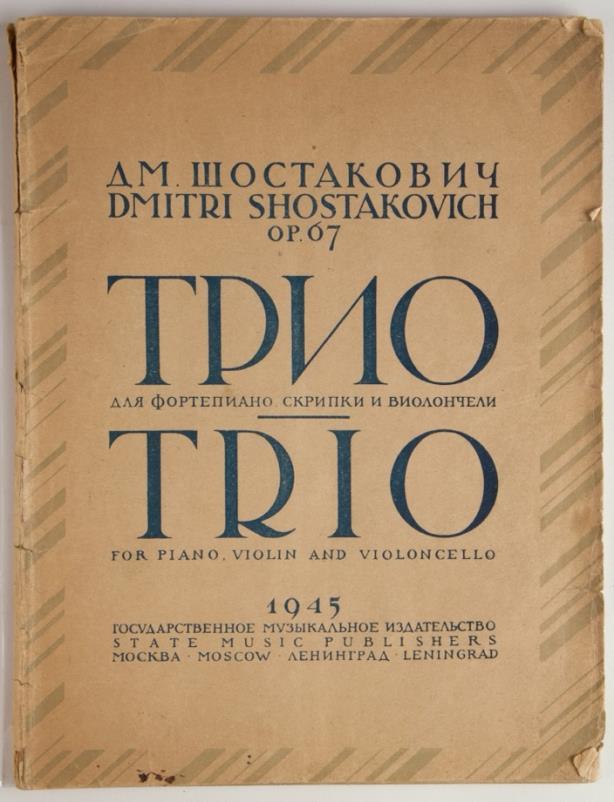
Inscribed and Signed by Shostakovich
27. SHOSTAKOVICH, Dmitri 1906-1975 Trio for Piano, Violin and Violoncello. [Op. 67]. Moscow: State Music Publishers [PN M. 18203 r.], 1945.
Quarto. Original publisher's dark ivory wrappers printed in dark blue with decorative light olive green striped border to margins of upper. [i] (title), 2-62 pp. With printed price and publisher's notes to foot of verso of lower wrapper. Preserved in a custom-made dark green morocco-backed clamshell box with dark green cloth boards, raised bands on spine with titling gilt. Wrappers somewhat worn and slightly soiled; small tears and chips to edges and spine with small portion of tail of spine lacking; hinges separating; upper wrapper partially detached at head. Slightly worn; uniformly browned; minor soiling to edges and creasing to corners. Inscription slightly smudged.
A presentation copy, with a signed autograph inscription by Shostakovich in green ink to upper inner corner of title [in translation from Russian]: "To Vladimir Yevgenyvich Neklyudov with best wishes D. Shostakovich 5 II 1946 Moscow."
First Edition. Hulme: Dimitri Shostakovich Catalogue, pp. 263-272.
Shostakovich's Second Piano Trio in E minor, incorporating Jewish themes, was composed at Shostakovich's home at Ivanovo and first performed in Leningrad at the Philharmonic Bolshoi Hall on 14 November 1944 with Dimitri Tsyganov (violin), Sergei Shirinsky (cello), and Shostakovich (piano).
"The Second Piano Trio was dedicated to the memory of the recently deceased Sollertinsky, and also paid concealed homage not only to his pupil Fleischmann, who had died at the Leningrad battlefront, but also to the victims of the Holocaust. Shostakovich began work early in 1944, around the time he finished the orchestration and completion of Fleischmann’s opera Rothchild’s Violin, whose memorable Jewish dance themes are echoed in the finale of Shostakovich’s Trio; this inaugurated a significant strand of musical imagery in his work. The Trio was not completed until August, and he followed on almost immediately with the Second String Quartet." David Fanning, and Laurel Fay in Grove Music Online
"Shostakovich's loss [of his close friend Ivan Sollertinsky] was incalculable. He offered his condolences to Sollertinsky's widow:"'It is impossible to express in words all the grief that engulfed me on hearing the news about Ivan Ivanovich's death. Ivan Ivanovich was my very closest and dearest friend. I am indebted to him for all my growth. To live without him will be unbearably difficult.' ... More than twenty years later, Shostakovich confessed in a television interview, 'When I work on new compositions, I always think, And what would Ivan Ivanovich have said about this?'
If Shostakovich felt unequal to the task of adequately paying tribute to his friend in words, he proved more than eloquent in music. He dedicated the first major work completed after Sollertinsky's death, the Piano Trio no. 2 ... to the memory of his friend." Fay: Shostakovich, p. 141. (40418) $1,750
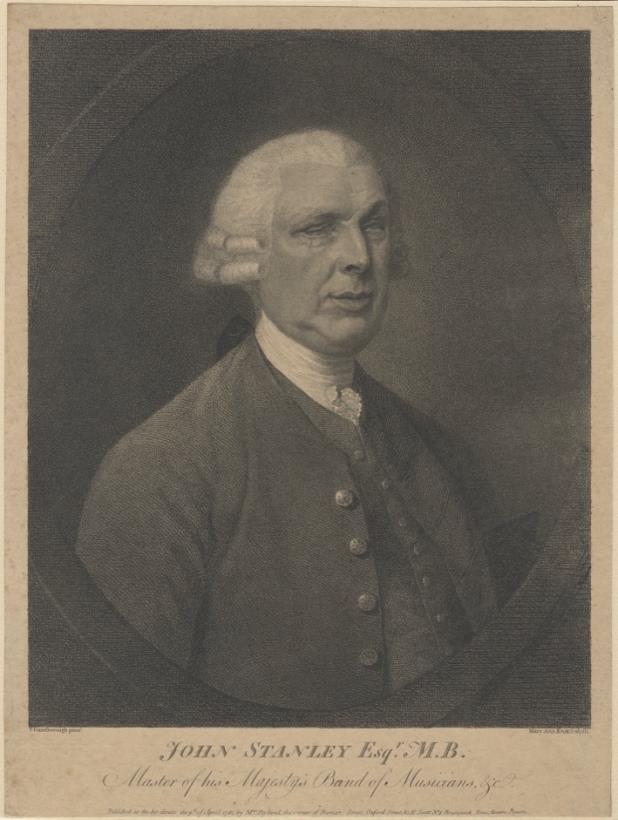
Lifetime Engraving of the Noted Blind British Composer, Organist, and Violinist
28. [STANLEY, John 1712-1786]
John Stanley Esqr. M. B. Master of his Majesty's Band of Musicians, etc. Published as the Act directs the 9th. of April 1781; by Mrs. Ryland, the corner of Berner Street, Oxford Street; & E. Scott No. 4 Brunswick Row, Queens Square. Stipple engraving with etching by Mary Ann Scott after the painting by Thomas Gainsborough. London: Mrs. Rayland, 1781.
328 x 246 mm. Laid down to mat. The subject, blind British composer, organist, and violinist John Stanley, is depicted in a circular frame, half-length facing three-quarter left. He wears an outer opened jacket, a waistcoat, cravat with lace ruffle, and wig.
British Museum number 1879,0614.818
$300
"According to his pupil John Alcock (i), Stanley's playing of voluntaries at the Temple and St Andrew's attracted musicians from all over London, including Handel. He was also an excellent violinist and for several years directed the subscription concerts at the Swan Tavern, Cornhill, and the Castle, Paternoster Row. In 1729 he became the youngest person to gain a BMus degree from Oxford University...Even more interesting,( than his sets of organ voluntaries) however, are the concertos and cantatas, which illustrate the part played by Stanley in the transition from the Handelian Baroque to the galant style associated in England with J.C. Bach. The six op.2 concertos are among the finest English string concertos in the Corelli–Handel tradition, and were popular enough to be reissued in arrangements for organ and as solos for violin, flute or harpsichord." Malcolm Boyd, revised by A.G. Williams in Grove Music Online (40404)
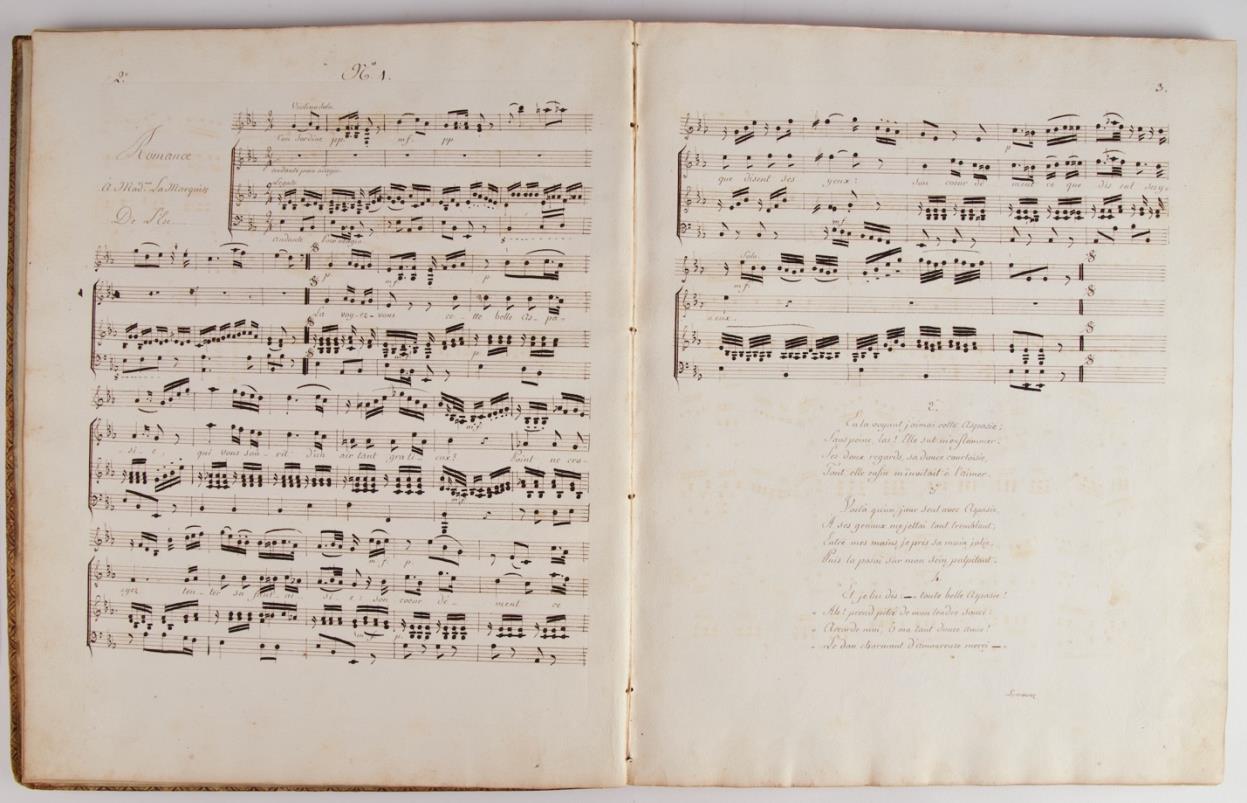
29. [VOCAL MUSIC - 18th Century - French - Manuscript]
Douze Chansons ou Romance avec accompagnement de forte Piano et Violon obligé À Marie. Late 18th century friendship/presentation musical manuscript.
Folio. Full dark red calf with elaborate tooling gilt incorporating floral motifs to margins of boards, "À Marie" gilt to upper, spine in decorative compartments gilt, blue silk endpapers. Preserved in a quarter dark red morocco clamshell box with matching dark red silk boards, raised bands on spine in decorative compartments gilt with titling gilt.
1f. (recto title, verso notes on performance), 1f. (recto dedication, verso blank), 48, [i] (contents). Watermark of a crown above a shield with fleur-de-lis and the name H BLUM. Text in French. Dedication
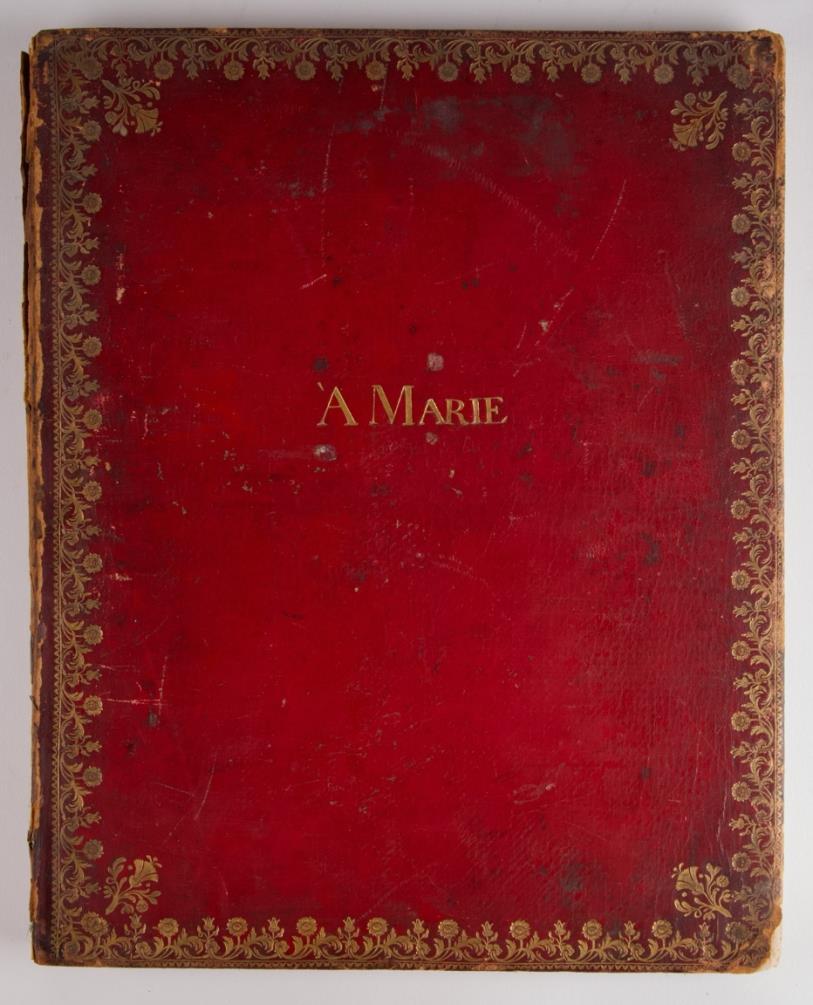
reads: "À Marie / L'Amour d'abord médita cel hommage: / C'est l'amitié qui vous l'offre en ce jour. / Que l'amitié le recoive à son tour: / Ce sentiment de tout me dédommage."
A finely executed calligraphic manuscript containing French songs set for voice, piano, and violin. The pieces appear to be original arrangements of contemporary and earlier songs. Binding somewhat worn and rubbed; minor loss to spine and corners; upper detached; hinges split. Some minor foxing, staining, soiling, and showthrough; some signatures loose; upper outer corner of title with contemporary signature crossed out and thus indecipherable. A very attractive and elegantly presented manuscript overall.
Contents:
No. 1. Romance À Madme. La Marquise De L'Ese (Imitée de la chanson De Monterif Elle m'aima cette Belle Aspasie)
No. 2. Romance À Madame Cr. ... (air ancien)
No. 3. Lai De Bliomberis (Voyez Bliomberis Nouvelle de M. De Florian)
No. 4. Couplets À Melle. De Lum
No. 5. Couplets Allégoriques Àk Mdme. De G. ... (Parodiés Sur un Rondeau de Mr. Pleyel)
No. 6. Paul Et Virginie. Romance. (Paroles de Mr. Doigni Du Ponceau)
No. 7. Romance À Nice
No. 8. Couplets À Nice
No. 9. Les Adieux De Némorin. (Voyez Estelle par Mr. De Florian)
No. 10. Autre Romance d'Estelle
No. 11. Romance À Melle De Ranc ...Tom Et Lucy Romance historique À Marie. L'anecdote qui fait le sujet de cette Romance à été inseee dans le Courier de L'Europe au mois de Juillet 1779 (40413)
$600
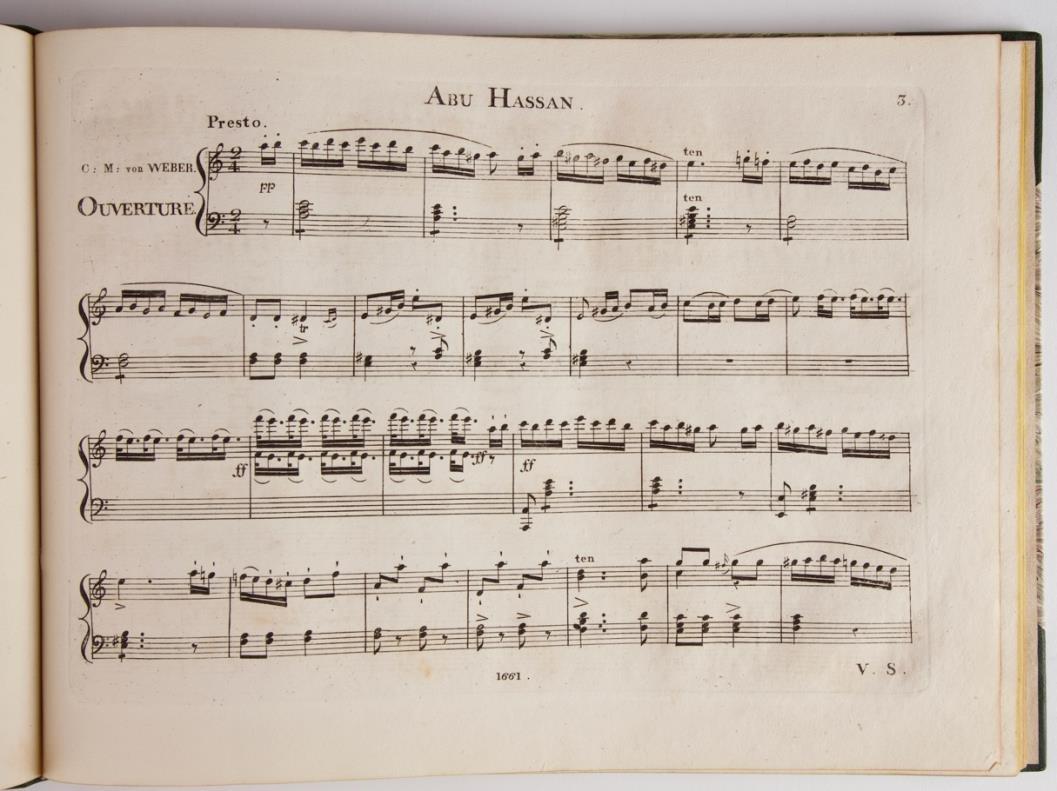
“The Earliest of Weber’s Operas to Have Enjoyed a ... More or Less Continuous Performance History”
30. WEBER, Carl Maria von 1876-1826
Abu Hassan Oper in einem Act. Gedicht von J.F. Hiemer ... Vollständiger Clavierauszug vom Componisten. Preis 10 Fr. [Piano-vocal score]. Bonn und Cöln: N. Simrock [PN 1661], [1819].
Oblong folio. 20th century half dark green morocco with marbled boards, titling to spine gilt. 1f. (recto title, verso blank), 1f. (recto "Personen" and contents listing the overture and 9 numbers, verso blank), 366 pp. Text in German. Engraved. Title slightly browned. A very nice clean and crisp copy overall.
First Edition. Jähns 106, p. 127. Hoboken Catalogue 15, 293. Hirsch IV, 1289.
Abu Hassan, composed between 11 August 1810 and 12 January 1811, was first performed in Munich at the Residenz on 4 June 1811.
With a plot based on The Thousand and One Nights, this one-act comic opera "is the earliest of Weber’s operas to have enjoyed a modest, but more or less continuous performance history. ... The great leap forward from Abu Hassan to Der Freischütz is less a matter of style or compositional technique than of clarification in Weber’s thinking about the problems of opera in general and German opera in particular. The six-year gap between the completion of Abu Hassan and the start of work on Der Freischütz allowed Weber as a critic and conductor to reflect upon questions of character, dramatic truth, and wholeness as they pertained to the lyric stage and to find in works that he admired – Mozart’s operas, the opéras comiques of Méhul and Cherubini, Beethoven’s Fidelio, Spohr’s Faust, and Hoffmann’s Undine – models for realizing his goals. ...
A prototypical 19th-century musician-critic, [Weber] sought through his works, words, and efforts as performer and conductor to promote art and shape emerging middle-class audiences to its appreciation. His contributions to song, choral music, and piano music were highly esteemed by his contemporaries, his opera overtures influenced the development of the concert overture and symphonic poem, and his explorations of novel timbres and orchestrations enriched the palette of musical sonorities. With the overwhelming success of his opera Der Freischütz in 1821 he became the leading exponent of German opera in the 1820s and an international celebrity. A seminal figure of the 19th century, he influenced composers as diverse as Marschner, Mendelssohn, Wagner, Meyerbeer, Berlioz, and Liszt." Michael C. Tusa in Grove Music Online (40410) $600
